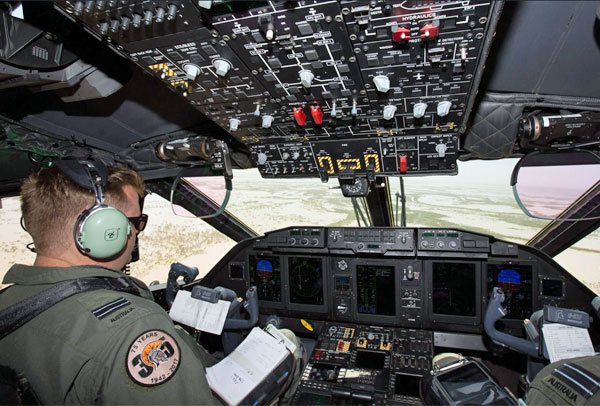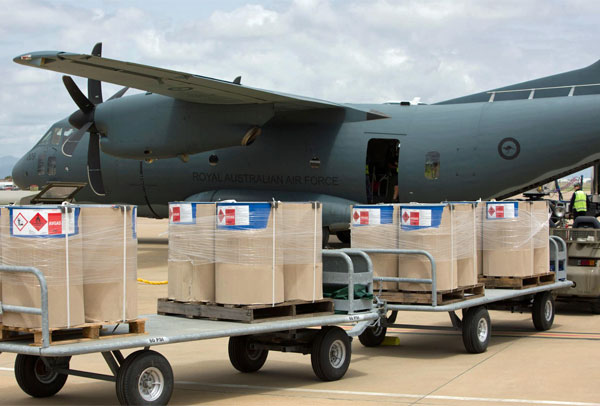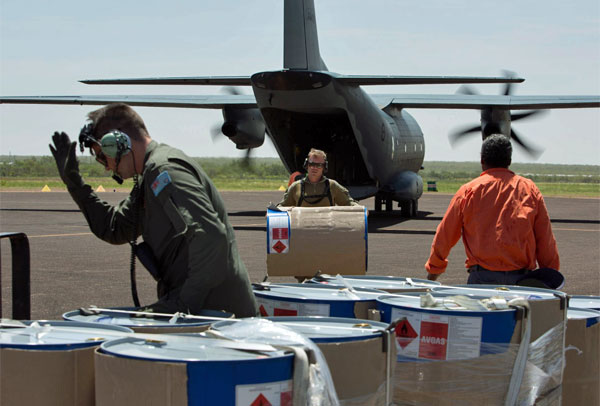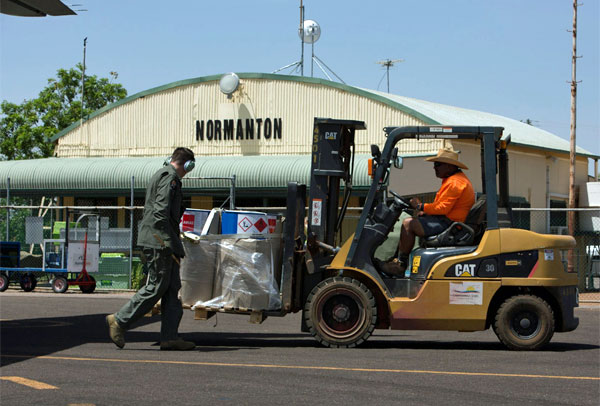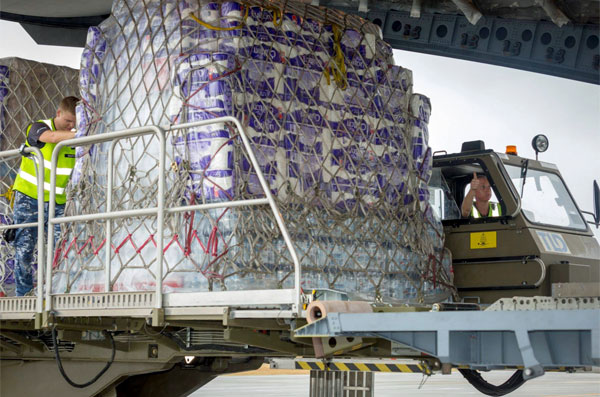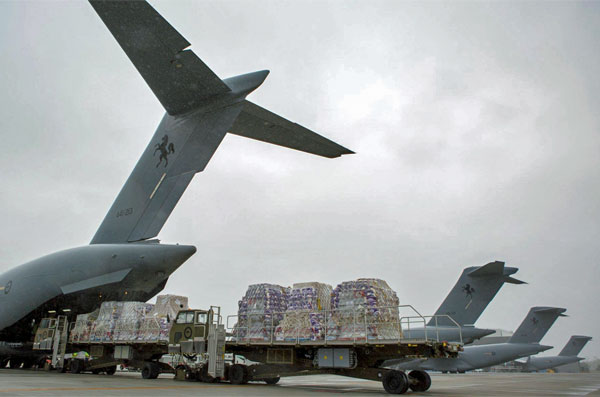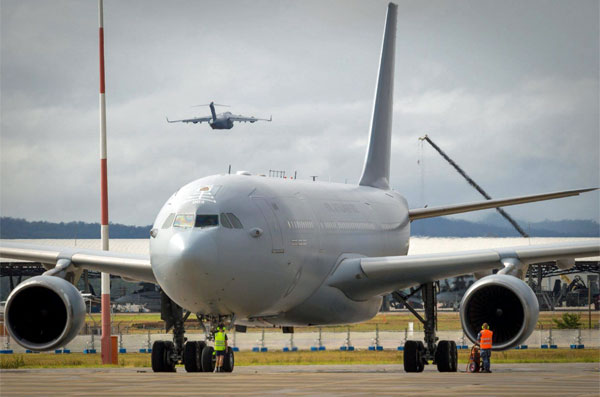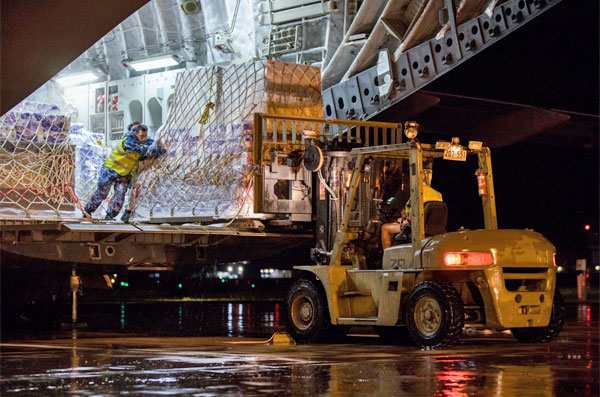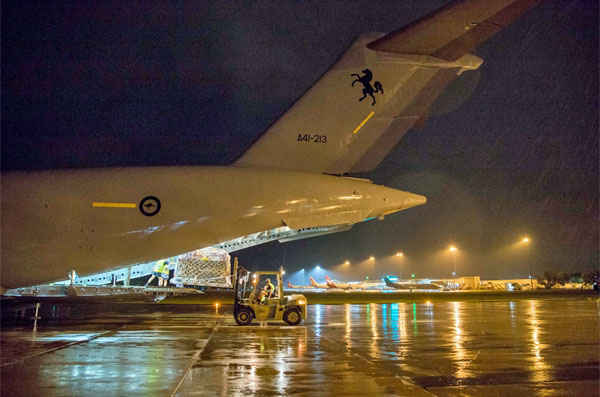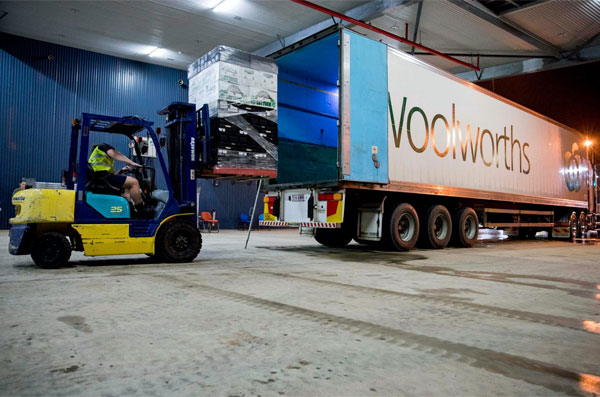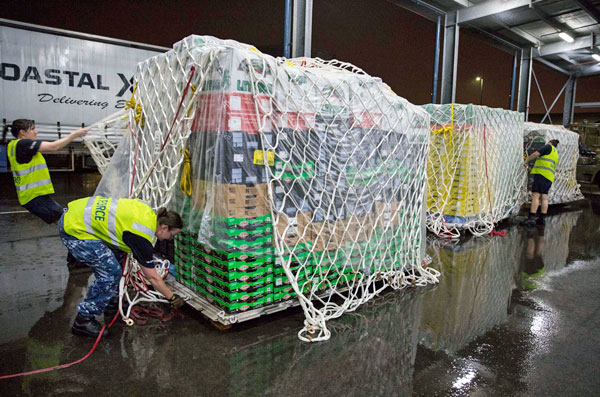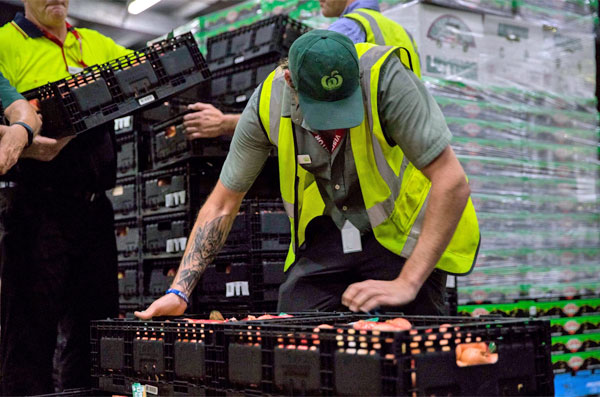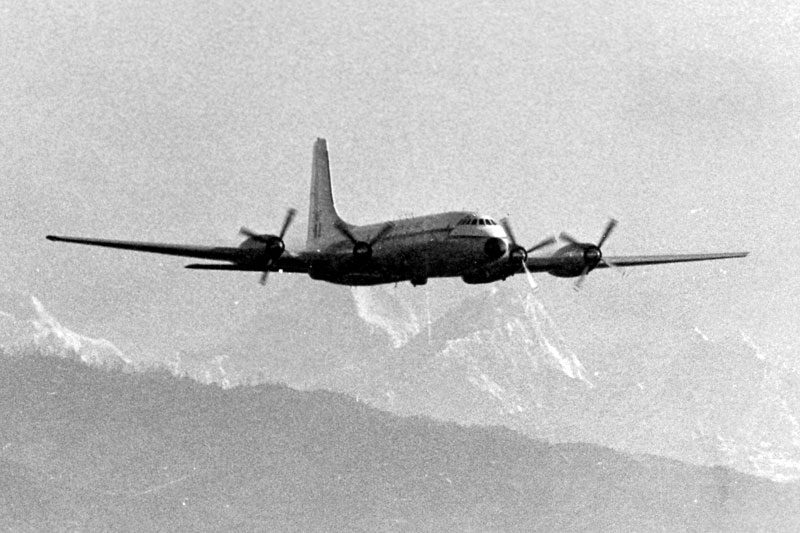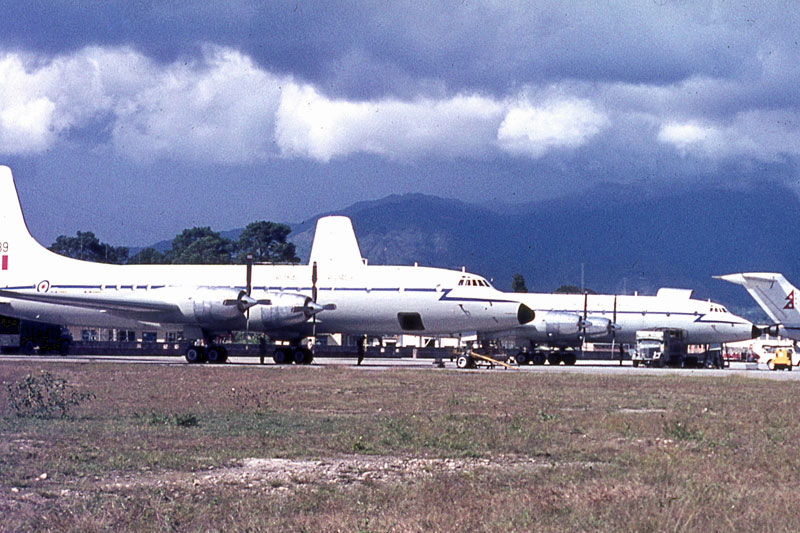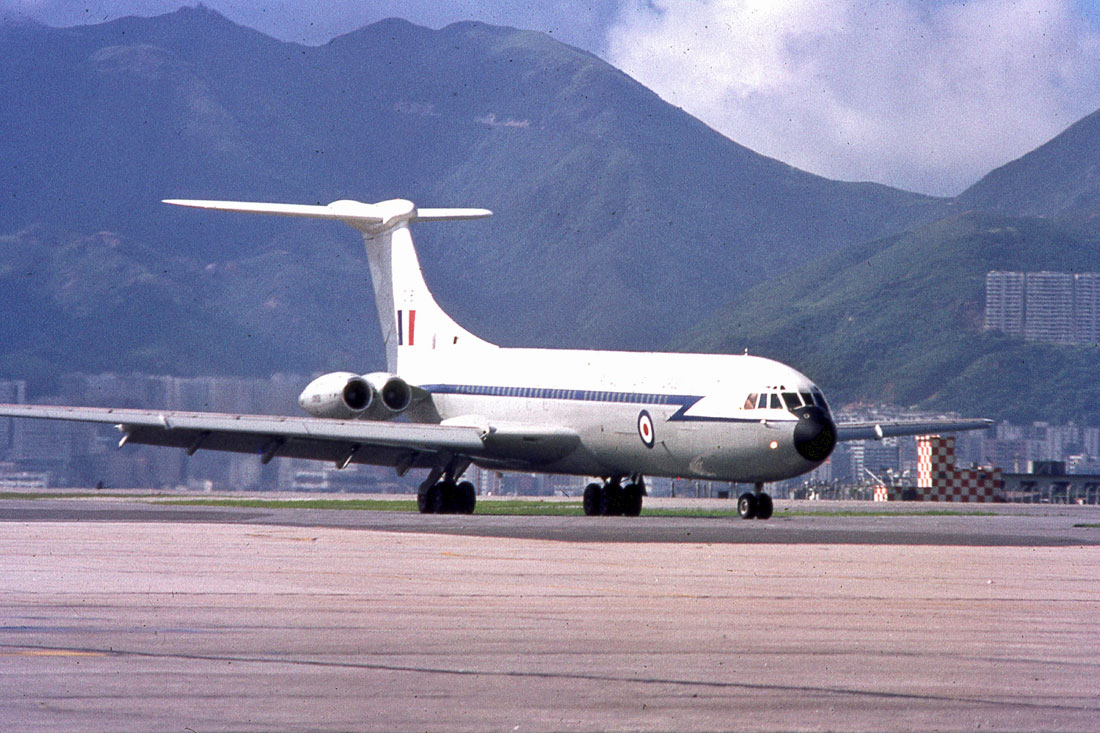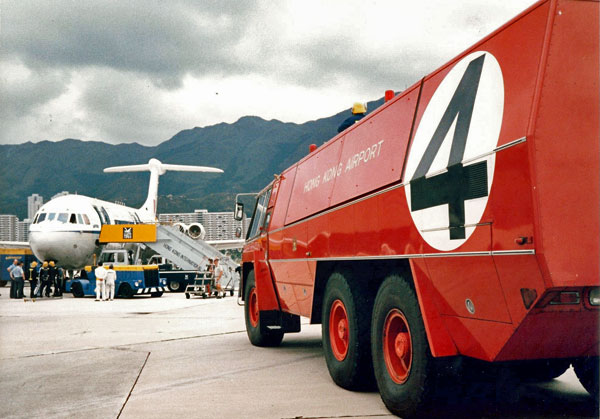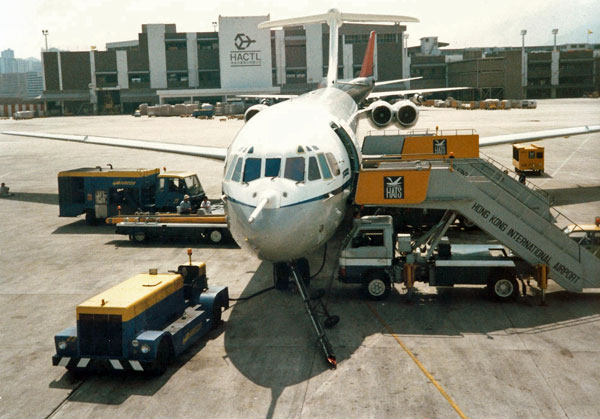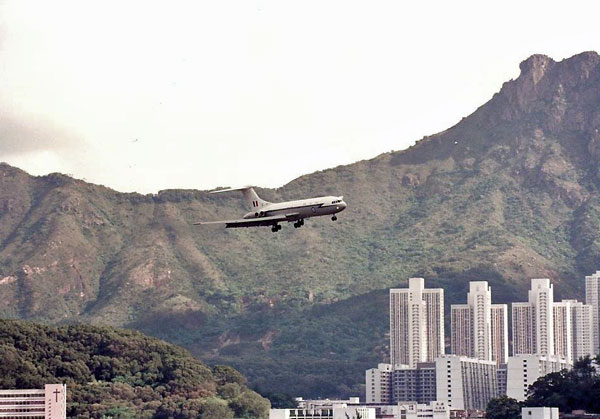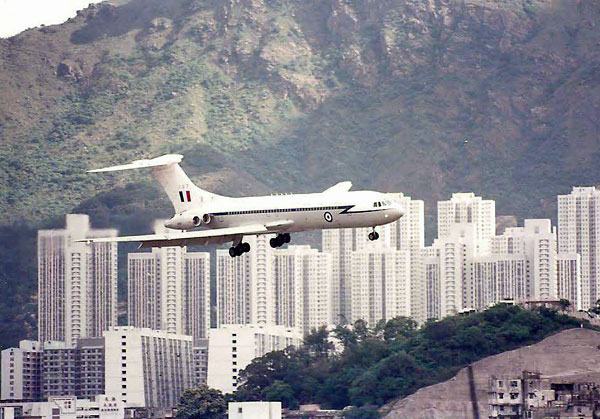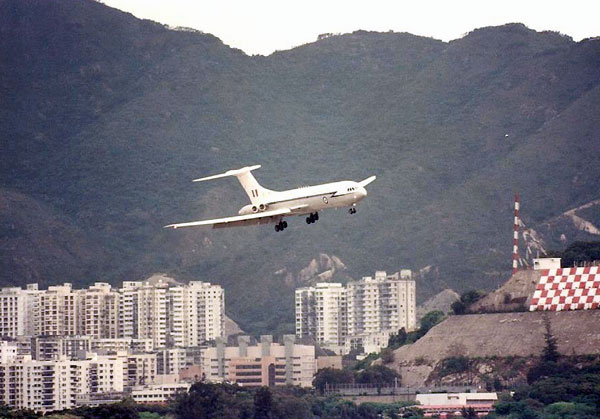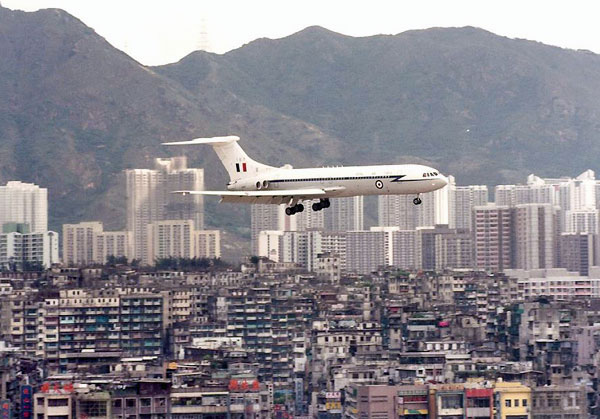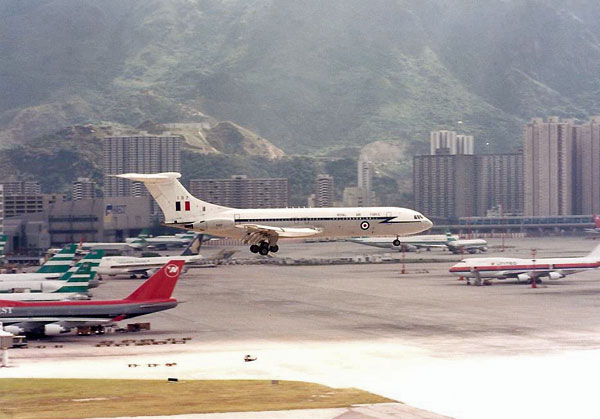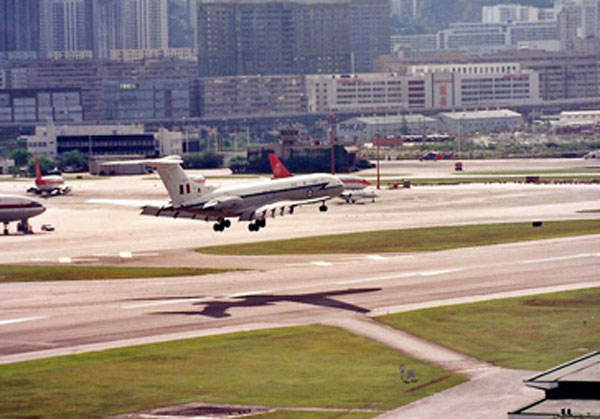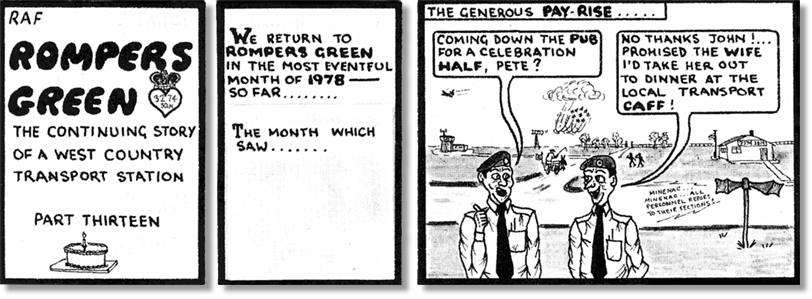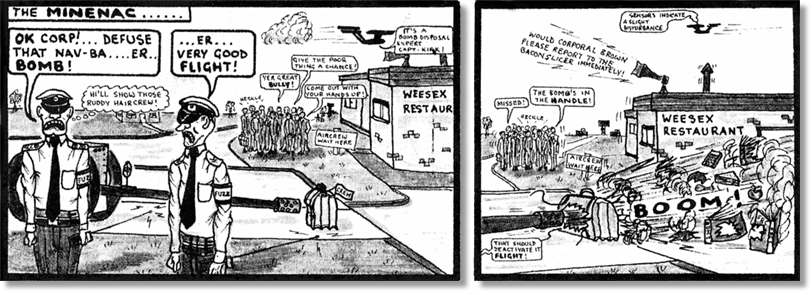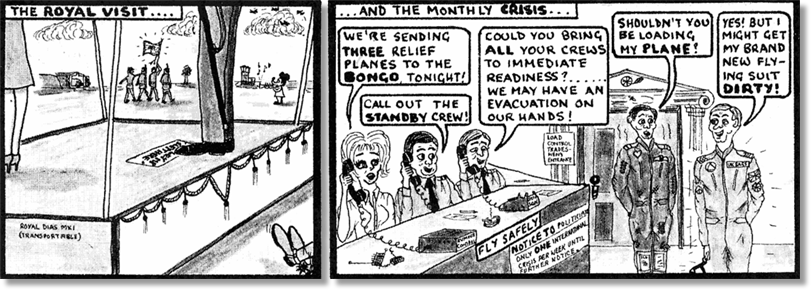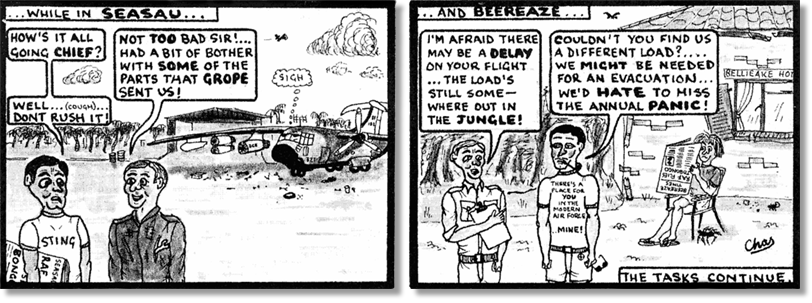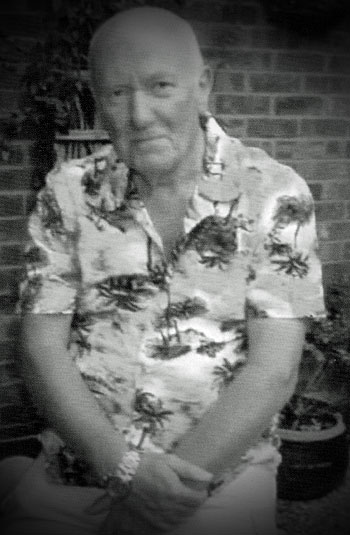With the imminent demise of the Royal Air Force Boy Entrant's Association, a Facebook Group has been created:
RAF Ex Boy Entrants Group
RAF Ex Boy Entrants Group
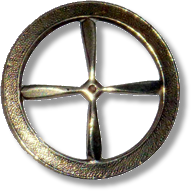

So, all you ex Boy Entrants out there - show your support for this new group - click on the Facebook logo above and join up!
From: Phil Smith, Exmouth, Devon
Subject: Suggestion for Topics - One Liners.
Hi Tony,
If you are struggling for ideas for topics regarding your excellent website, can I suggest the following.
During my first tour on UKMAMS there used to be a 'One Liner" book in the crew room where blokes could list the humorous one-line put downs they came across or indeed came up with. For example :
We landed in Nairobi with Land Rovers in the back of a Hercules. As we started the off load "Colonel Blimp" British Army, arrived at the ramp of the aircraft expecting to see his vehicles in Desert Sand Yellow colouring and not the White which they were. He then asked loudly in a very pompous manner "Since when did they start painting vehicles white?"
"It was just after they ran out of yellow paint!" came the reply (I do have to take credit for that one, Tony).
What do you think ? I`m sure blokes can come up with a few good ones.
Regards.
Phil
Subject: Suggestion for Topics - One Liners.
Hi Tony,
If you are struggling for ideas for topics regarding your excellent website, can I suggest the following.
During my first tour on UKMAMS there used to be a 'One Liner" book in the crew room where blokes could list the humorous one-line put downs they came across or indeed came up with. For example :
We landed in Nairobi with Land Rovers in the back of a Hercules. As we started the off load "Colonel Blimp" British Army, arrived at the ramp of the aircraft expecting to see his vehicles in Desert Sand Yellow colouring and not the White which they were. He then asked loudly in a very pompous manner "Since when did they start painting vehicles white?"
"It was just after they ran out of yellow paint!" came the reply (I do have to take credit for that one, Tony).
What do you think ? I`m sure blokes can come up with a few good ones.
Regards.
Phil
From: Neil Collie, Canberra, ACT
Subject: Demarcation
Hi Tony,
Saw this photo in a military website. Clearly it was intended to demonstrate that only Army paras go ‘out the door’. My view on it however, is to demonstrate exactly where Army movers stop and RAF, RAAF, RNZAF start!
Happy New Year
Neil Collie
Subject: Demarcation
Hi Tony,
Saw this photo in a military website. Clearly it was intended to demonstrate that only Army paras go ‘out the door’. My view on it however, is to demonstrate exactly where Army movers stop and RAF, RAAF, RNZAF start!
Happy New Year
Neil Collie
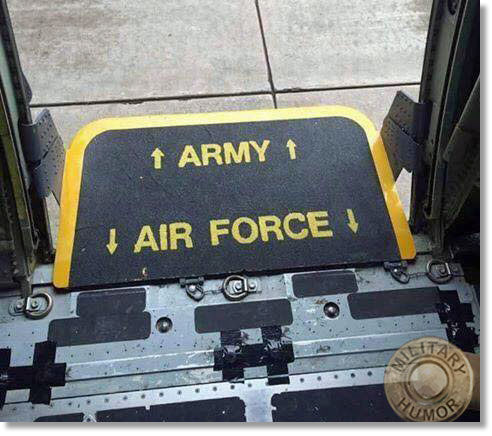

Relief from the Skies

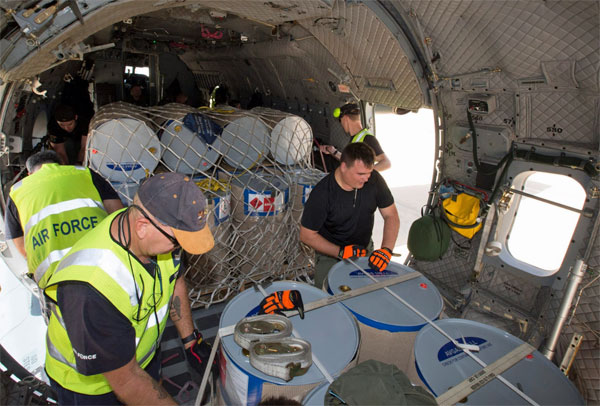
Our agile Spartans prove their worth in a disaster zone as flooded farmers welcome delivery of vital supplies. No. 35 Squadron C-27J aircraft and personnel from RAAF Base Amberley responded swiftly to deliver personnel and urgent fuel stocks to Mt Isa and western Queensland in support of flood relief efforts.
The first two flights to western Queensland on February 9 were the first ones of the year for the squadron. It marked the start of flying operations two days earlier than had been scheduled from their new base at Amberley.
Loadmaster SGT Jay Goggin said two C-27J Spartans and crew worked with Army personnel from 9th Force Support Battalion to load collapsible bladders containing 1895 litres of much-needed fuel. “The fuel bladders were delivered to the isolated areas of Richmond and Julia Creek for local civilian helicopters dropping fodder and hay to farmers and livestock devastated by the extreme weather conditions,” SGT Goggin said.
The first two flights to western Queensland on February 9 were the first ones of the year for the squadron. It marked the start of flying operations two days earlier than had been scheduled from their new base at Amberley.
Loadmaster SGT Jay Goggin said two C-27J Spartans and crew worked with Army personnel from 9th Force Support Battalion to load collapsible bladders containing 1895 litres of much-needed fuel. “The fuel bladders were delivered to the isolated areas of Richmond and Julia Creek for local civilian helicopters dropping fodder and hay to farmers and livestock devastated by the extreme weather conditions,” SGT Goggin said.
XO 35SQN SQNLDR Mark Seery said the deployed team consisted of pilots, loadmasters, technicians and engineers who flew the supplies more than 1500km to western Queensland. “The C-27J Spartan is an agile aircraft that can land in austere airfields and along dirt strips enabling the quick insertion of supplies to areas that need it most, and would have otherwise been inaccessible for larger aircraft or via road transport,” SQNLDR Seery said. 35SQN will continue to provide assistance in support of the north Queensland flood relief efforts over the coming weeks.
CO 35SQN WGCDR Ben Poxon said the ongoing flood relief response was a “hub and spoke” operation that highlighted the strength and flexibility of the air mobility fleet. The squadron was working closely with C-17A Globemaster aircraft to move more supplies to those affected by the floods. “The C-17A flew multiple fuel bladders into larger, more established airfields (hub) like Mt Isa airport, from where the C-27J transported to smaller, remote airfields (spoke) where Army personnel are waiting to unload,” WGCDR Poxon said.
CO 35SQN WGCDR Ben Poxon said the ongoing flood relief response was a “hub and spoke” operation that highlighted the strength and flexibility of the air mobility fleet. The squadron was working closely with C-17A Globemaster aircraft to move more supplies to those affected by the floods. “The C-17A flew multiple fuel bladders into larger, more established airfields (hub) like Mt Isa airport, from where the C-27J transported to smaller, remote airfields (spoke) where Army personnel are waiting to unload,” WGCDR Poxon said.
Royal Australian Air Force

Townsville Flood Assistance
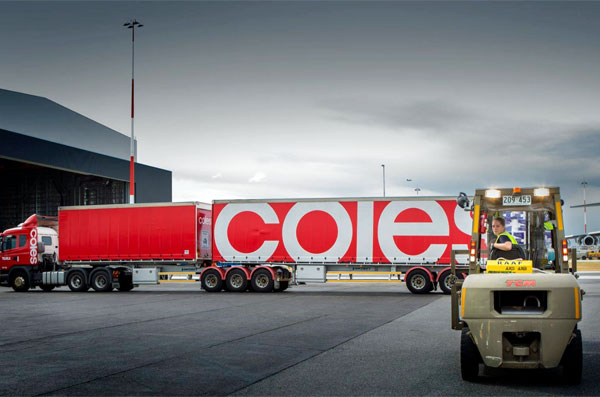
In a 24-hour period, both No. 36 Squadron Air Crew and No. 23 Squadron Air Movements personnel delivered on the call for groceries urgently needed in Townsville. Due to extreme weather conditions and unprecedented rainfall in early February, it was difficult for the road and rail movement of essential supplies and fresh food into North Queensland.
Squadron Leader Ben Barber, Air Movements Flight Commander, said a 40-strong team of movements, supply and loadmaster personnel came together on 5 February at RAAF Base Amberley.
They worked to unload and pack 72 tonnes of stores trucked onto base by Woolworths and Coles.
“The first aircraft was loaded with 90,000 pounds of supplies and the second had 53,000 pounds,” Squadron Leader Barber said. “This included fresh fruit and vegetables as well as essentials like bottled water.”
Squadron Leader Ben Barber, Air Movements Flight Commander, said a 40-strong team of movements, supply and loadmaster personnel came together on 5 February at RAAF Base Amberley.
They worked to unload and pack 72 tonnes of stores trucked onto base by Woolworths and Coles.
“The first aircraft was loaded with 90,000 pounds of supplies and the second had 53,000 pounds,” Squadron Leader Barber said. “This included fresh fruit and vegetables as well as essentials like bottled water.”
Flight Lieutenant Tim Smith was captain of the second C-17A Globemaster carrying the stores, and said three aircraft each carried seven pallets to Townsville. “Helping the community in emergency situations like is a rewarding experience for the crew and not a task we take lightly,” Flight Lieutenant Smith said.
Echoing this, Commanding Officer of 36SQN Wing Commander Steve Ferguson said the squadron is committed to being the asset of choice for ADF responses to humanitarian aid and disaster relief. “We have a unique capability to respond very quickly and on a large scale to disaster relief efforts both at home in Australia and in our region. 36SQN takes pride in being among the first responders” said Wing Commander Ferguson. “I also commend those in Townsville who were on the ground assisting, and continue to despite their own homes being affected by floodwaters.”
Over 2,800 Australian Defence Force personnel from Air Force and Army were actively engaged in supporting the disaster response.
Echoing this, Commanding Officer of 36SQN Wing Commander Steve Ferguson said the squadron is committed to being the asset of choice for ADF responses to humanitarian aid and disaster relief. “We have a unique capability to respond very quickly and on a large scale to disaster relief efforts both at home in Australia and in our region. 36SQN takes pride in being among the first responders” said Wing Commander Ferguson. “I also commend those in Townsville who were on the ground assisting, and continue to despite their own homes being affected by floodwaters.”
Over 2,800 Australian Defence Force personnel from Air Force and Army were actively engaged in supporting the disaster response.
Royal Australian Air Force

From David Powell, Princes Risborough
Subject: [Belated] Memories of the Whispering Giant
Dear Tony,
When I turned on the old grey cells to meeting this latest challenge, the first thing that happened was that I was smiling! Yes, “Britannia?” for me means a lot of just plain happy memories. No heart pounding excitement, no funny incidents (at least in the aircraft) or gut-wrenching dramas. It was just a very nice aircraft to have flown in.
One significant memory that is coming back, is the (wish there was a nice polite term for it) unique distinctive smell of the Brit. This was different to our other bread and butter task transports – Beverley, Argosy, Hercules and occasionally the VC-10. It may have been the legacy of well-used triple seats, the accumulated pong of thousands of Lyneham lunch boxes, with a light airborne tang of hydraulic oil and a splash of AVTUR collected during turnarounds. Or, maybe did Brit AQMs have a deal at some route staging post for the bulk purchase of a standard aftershave?
The next happy memory to bubble to the surface is that of fantastic views of cloud formations. Unlike the Beverley, which flew under them, the Argosy which always seemed to fly in them courtesy of its cloud hunting nose radar, or the VC-10 which flew very high above them; Belfasts and Hercs only came in an economy no-nice-windows-to-look-out-of version.
And, another Britannia memory? This was the RAF version of birthday bumps when loading Landrovers through the forward freight door and into the forward main body where the freight travelled. This required the team to form a circle round the vehicle; grab a suitable firm projection (such as the bumper – not the wing mirrors), and in unison ‘bounce’ the Landrover on its springs. Then when the vehicle was at the top of the bounce, and approaching zero gravity weightlessness (well a bit), as one we would collectively ‘jig’ or jog’ the vehicle clockwise depending where you were standing, so that it could be slid on its tires. Thereby turning the vehicle on the spot through 90 degrees! Job done! There was also a rumour, although I couldn’t possibly comment, that it was during the excitement of this particular loading technique, that the fixing bolts of Military Police Vehicle Bumper Identity Plates could be surreptitiously loosened. Mind you, I never did find out why?
Not for nothing for many years was the Britannia the mainstay of my long-haul off-route MAMS PCF tasks, and during the 60s the Whispering Giant took me to Australia, Canada, Hawaii, USA and the Caribbean. Tasks made even more enjoyable by the opportunity of a ‘Brit Engine Change’.
Memories of the Britannia – pass the malt and so to bed with smile.
Best wishes to all movers, have a great 2019.
David Powell
F Team RAF Abingdon 1967-69
Subject: [Belated] Memories of the Whispering Giant
Dear Tony,
When I turned on the old grey cells to meeting this latest challenge, the first thing that happened was that I was smiling! Yes, “Britannia?” for me means a lot of just plain happy memories. No heart pounding excitement, no funny incidents (at least in the aircraft) or gut-wrenching dramas. It was just a very nice aircraft to have flown in.
One significant memory that is coming back, is the (wish there was a nice polite term for it) unique distinctive smell of the Brit. This was different to our other bread and butter task transports – Beverley, Argosy, Hercules and occasionally the VC-10. It may have been the legacy of well-used triple seats, the accumulated pong of thousands of Lyneham lunch boxes, with a light airborne tang of hydraulic oil and a splash of AVTUR collected during turnarounds. Or, maybe did Brit AQMs have a deal at some route staging post for the bulk purchase of a standard aftershave?
The next happy memory to bubble to the surface is that of fantastic views of cloud formations. Unlike the Beverley, which flew under them, the Argosy which always seemed to fly in them courtesy of its cloud hunting nose radar, or the VC-10 which flew very high above them; Belfasts and Hercs only came in an economy no-nice-windows-to-look-out-of version.
And, another Britannia memory? This was the RAF version of birthday bumps when loading Landrovers through the forward freight door and into the forward main body where the freight travelled. This required the team to form a circle round the vehicle; grab a suitable firm projection (such as the bumper – not the wing mirrors), and in unison ‘bounce’ the Landrover on its springs. Then when the vehicle was at the top of the bounce, and approaching zero gravity weightlessness (well a bit), as one we would collectively ‘jig’ or jog’ the vehicle clockwise depending where you were standing, so that it could be slid on its tires. Thereby turning the vehicle on the spot through 90 degrees! Job done! There was also a rumour, although I couldn’t possibly comment, that it was during the excitement of this particular loading technique, that the fixing bolts of Military Police Vehicle Bumper Identity Plates could be surreptitiously loosened. Mind you, I never did find out why?
Not for nothing for many years was the Britannia the mainstay of my long-haul off-route MAMS PCF tasks, and during the 60s the Whispering Giant took me to Australia, Canada, Hawaii, USA and the Caribbean. Tasks made even more enjoyable by the opportunity of a ‘Brit Engine Change’.
Memories of the Britannia – pass the malt and so to bed with smile.
Best wishes to all movers, have a great 2019.
David Powell
F Team RAF Abingdon 1967-69

From: Brian Hunt, Brighton, East Sussex
Subject: The Whispering Giant
Dear Tony
I have attached a few shots of Britannias at Kathmandu, with the Himalayas in the background, that you may like to share with the old bods.
There used to be 3 flights a week bringing Gurkhas for their three yearly, six months leave. The crew would stay overnight in Britannia House and return to Hong Kong the following day. They had to stop in Calcutta each way because there was insufficient fuel for them in Kathmandu.
The crews hated getting stuck in Calcutta because of all the hassle and would do anything to avoid stopping there! One flight arrived with its wheels down and another had only three engines working properly, as soon as they got to the top of the drop the fourth engine packed up!
Yours,
Brian
Subject: The Whispering Giant
Dear Tony
I have attached a few shots of Britannias at Kathmandu, with the Himalayas in the background, that you may like to share with the old bods.
There used to be 3 flights a week bringing Gurkhas for their three yearly, six months leave. The crew would stay overnight in Britannia House and return to Hong Kong the following day. They had to stop in Calcutta each way because there was insufficient fuel for them in Kathmandu.
The crews hated getting stuck in Calcutta because of all the hassle and would do anything to avoid stopping there! One flight arrived with its wheels down and another had only three engines working properly, as soon as they got to the top of the drop the fourth engine packed up!
Yours,
Brian
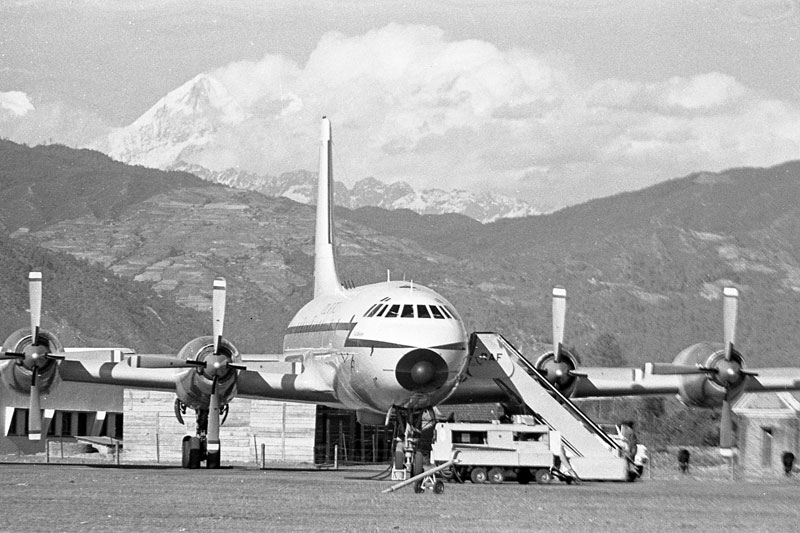

From: Richard Lloyd, Dalgety Bay, Fife
Subject: Britannia
Hi Tony,
Thanks once again for an amazing and absorbing UKMAMSOBA newsletter just issued.
I’m sorry that I failed to add to the Britannia story owing to: busyness/too much time in the pub/aging* and hope you’ll accept this late entry.
(* delete as you may deem appropriate.)
Following a very nice time at Lyneham as a supernumerary in 1966/67, and taking advantage of many off-shift flights to exciting destinations, I was posted to RAF Khormaksar as a Traffic Officer reporting to that great gentleman, Dick Whitworth. Imagine our surprise when coming on shift one morning to find this Brit at the sticky end of the runway. As I recall the VIP passenger was the Judge Advocate General who was coming to us to court martial a well-known Hunter pilot whom I shall not name. Dramatic arrival or what?
Richard (Dick) Lloyd
Subject: Britannia
Hi Tony,
Thanks once again for an amazing and absorbing UKMAMSOBA newsletter just issued.
I’m sorry that I failed to add to the Britannia story owing to: busyness/too much time in the pub/aging* and hope you’ll accept this late entry.
(* delete as you may deem appropriate.)
Following a very nice time at Lyneham as a supernumerary in 1966/67, and taking advantage of many off-shift flights to exciting destinations, I was posted to RAF Khormaksar as a Traffic Officer reporting to that great gentleman, Dick Whitworth. Imagine our surprise when coming on shift one morning to find this Brit at the sticky end of the runway. As I recall the VIP passenger was the Judge Advocate General who was coming to us to court martial a well-known Hunter pilot whom I shall not name. Dramatic arrival or what?
Richard (Dick) Lloyd
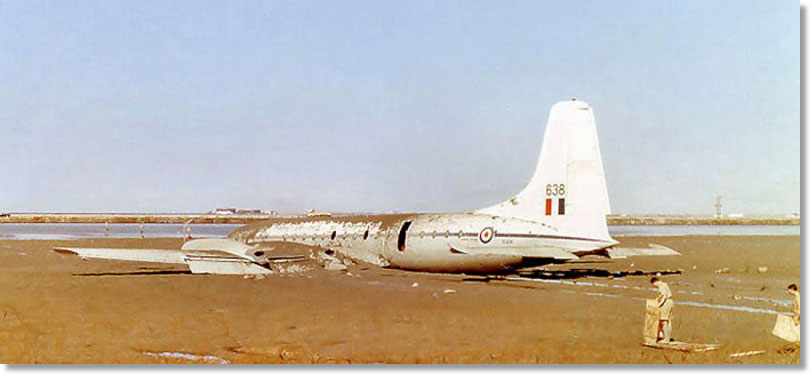
From: Alexander Angus, Kippax, Yorkshire
Subject: Memories of the Whispering Giant
The most prominent memory is of the Britannia that didn't stop at the end of the runway.
Two of us were sent to retrieve the diplomatic mail, and although duckboards (of a sort) were put down, somehow the mud reached half way to the knee, and did it stink! After we had retrieved the mail, the DAMO wouldn't let us anywhere near the Land Rover, so we set off walking back to the Movements Section.
There's more to come though. We were halfway back and the boss came out again. "You'll have to go back out there - someone is missing, go have a look." We really weren't in the mood for finding a corpse, still, back through that foul stench with torches, thankfully turned up no one. It transpired that the missing pillock was knocking whiskies back in the comfort of Neddies bar. I wish I could remember who else endured that little jaunt.
Cheers
Alex
Subject: Memories of the Whispering Giant
The most prominent memory is of the Britannia that didn't stop at the end of the runway.
Two of us were sent to retrieve the diplomatic mail, and although duckboards (of a sort) were put down, somehow the mud reached half way to the knee, and did it stink! After we had retrieved the mail, the DAMO wouldn't let us anywhere near the Land Rover, so we set off walking back to the Movements Section.
There's more to come though. We were halfway back and the boss came out again. "You'll have to go back out there - someone is missing, go have a look." We really weren't in the mood for finding a corpse, still, back through that foul stench with torches, thankfully turned up no one. It transpired that the missing pillock was knocking whiskies back in the comfort of Neddies bar. I wish I could remember who else endured that little jaunt.
Cheers
Alex

From: Wayne Harker, Edmonton, AB
Subject: CL144 Yukon Freighter
Tony,
I missed the last deadline for the Britannia but thought I would send this along.
My first MAMS exercise in 1970 was "Arctic Express" loading passengers and vehicles out of Pat Bay (Victoria) British Columbia shipping to the northern flank in Norway. Although most of our loads were handled by the C-130 we did have some loads on the Yukon.
The floor of the Yukon was not stressed for carrying wheeled vehicles so we had to utilize huge wooden shoring. I would be guessing now, but I estimate that the shoring was at least 4" thick and about 12" wide. I don't know how long, possibly 8 or ten ft long. They were very heavy.
Another awkward item to load were personal rucksacks. The Yukon had rollerized belly floors to accommodate baggage containers and working on your knees on those rollers was hell. Also, I recall a mover who was known to vent air in there and it would just about bring tears to your eyes and drive everyone out. That exercise was a real eye opener for a young tradesman not long after his basic trades training.
Cheers
Wayne Harker
Subject: CL144 Yukon Freighter
Tony,
I missed the last deadline for the Britannia but thought I would send this along.
My first MAMS exercise in 1970 was "Arctic Express" loading passengers and vehicles out of Pat Bay (Victoria) British Columbia shipping to the northern flank in Norway. Although most of our loads were handled by the C-130 we did have some loads on the Yukon.
The floor of the Yukon was not stressed for carrying wheeled vehicles so we had to utilize huge wooden shoring. I would be guessing now, but I estimate that the shoring was at least 4" thick and about 12" wide. I don't know how long, possibly 8 or ten ft long. They were very heavy.
Another awkward item to load were personal rucksacks. The Yukon had rollerized belly floors to accommodate baggage containers and working on your knees on those rollers was hell. Also, I recall a mover who was known to vent air in there and it would just about bring tears to your eyes and drive everyone out. That exercise was a real eye opener for a young tradesman not long after his basic trades training.
Cheers
Wayne Harker
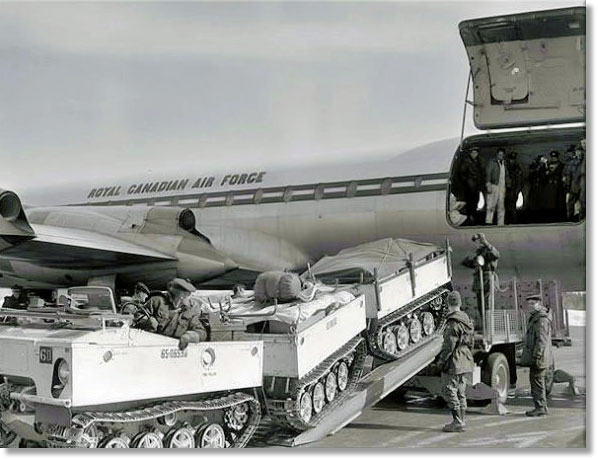

From: Pauline Andrews, Swindon, Wilts
Subject: Re: UKMAMS OBA OBB #012519
Hi Tony,
Interesting last edition, even though I'm too young to remember the Britannia, other than at Kemble.
It's great to see the Rompers Green series being published; I'm sure I've got them somewhere on a computer (although it may be at the job I left last year), they are truly gold!
Regards
Pauline Andrews
Subject: Re: UKMAMS OBA OBB #012519
Hi Tony,
Interesting last edition, even though I'm too young to remember the Britannia, other than at Kemble.
It's great to see the Rompers Green series being published; I'm sure I've got them somewhere on a computer (although it may be at the job I left last year), they are truly gold!
Regards
Pauline Andrews

The UK Armed Forces Veterans ID Card Launches
The Ministry of Defence launches the new Veterans ID card today, February 18, 2019, which will enable public and charitable sector services to instantly recognise the service of a Veteran. This card will provide proof that a Veteran has served in HM Armed Forces in line with the Government definition of a Veteran, which is one day’s service.
Currently, there is no way for existing Veterans to easily prove the fact that they have served, and the administrative burden on providers when verifying that a person is a Veteran can be considerable, both in time and cost. This card will allow organisations to confidentially verify that someone has served in the Armed Forces.
Delivery will be rolled out in two tranches:
Phase 1: The Veterans ID Card will be provided to all Service Leavers only, as part of the discharge process with effect from today, and retrospectively to those who left on or after 17 December 2018.
Currently, there is no way for existing Veterans to easily prove the fact that they have served, and the administrative burden on providers when verifying that a person is a Veteran can be considerable, both in time and cost. This card will allow organisations to confidentially verify that someone has served in the Armed Forces.
Delivery will be rolled out in two tranches:
Phase 1: The Veterans ID Card will be provided to all Service Leavers only, as part of the discharge process with effect from today, and retrospectively to those who left on or after 17 December 2018.
Phase 2: Applications from the wider Veteran Community will be encouraged once the process has been agreed. Information on how to apply will be made available closer to the time, before the end of 2019.
If you have any questions about the ID card, please contact the Veterans UK helpline number below and they will be able to provide the relevant information.
Telephone: 0808 1914 218
Website – www.veterans-uk.info
MORE DETAILS FROM MOD HERE
If you have any questions about the ID card, please contact the Veterans UK helpline number below and they will be able to provide the relevant information.
Telephone: 0808 1914 218
Website – www.veterans-uk.info
MORE DETAILS FROM MOD HERE
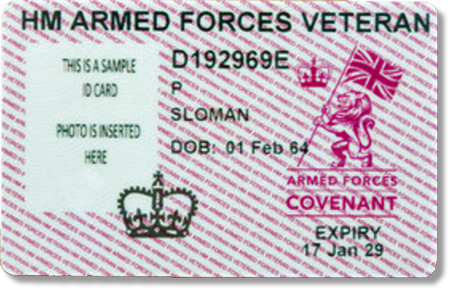

RAAF C-130J Pops Flares over Sydney Harbour for Australia Day 2019

New members joining us recently are:
Alec Angus, Kippax, Leeds
David Taylor (Honorary), York
Conrad Steele-Benny, Nottingham
Dan Dupuis, Comox, BC
Mervyn Corke, Swindon, Wilts
Peter Polidano, Marsaskala
Roy Irish, Exeter, Devon
Andy Gell, Truro, Cornwall
Welcome to the OBA!

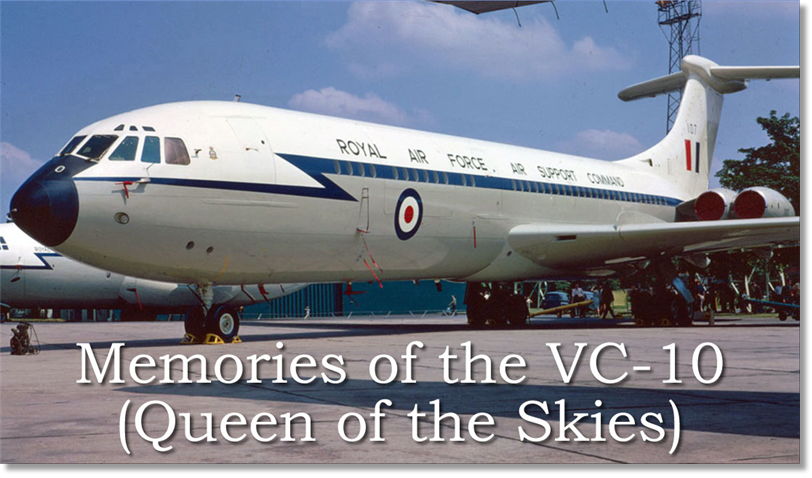
In 1960, the RAF issued Specification 239 for a strategic transport, placed by the Air Ministry with Vickers in 1961 as an order for five VC10s. The military version (Type 1106) was a combination of the Standard combi airframe with the developed wing and Super VC10 engines. It also had a detachable in-flight refuelling nose probe and an auxiliary power unit in the tail cone. The order was increased by an additional six in 1963, plus the three that BOAC had cancelled in 1964. The first RAF machine (known to the service as the VC-10 C Mk. 1, often abbreviated to VC-10 C1), was delivered for testing on 26 November 1965, with deliveries to No. 10 Squadron beginning in December 1966 and ending in August 1968. They were serial numbers XR806 to XR810 and XV101 to XV109.
Aircraft XR809 was leased to Rolls-Royce for flight testing of the RB211 turbofan between 1969 and 1975. On return to the RAF it was found that the airframe had become distorted. It considered uneconomical to repair and was instead used for for SAS training, before being scrapped.
[To see a more complete history of the VC-10 in RAF service go here: http://ukmamsoba.org/history_vc10.htm]
Aircraft XR809 was leased to Rolls-Royce for flight testing of the RB211 turbofan between 1969 and 1975. On return to the RAF it was found that the airframe had become distorted. It considered uneconomical to repair and was instead used for for SAS training, before being scrapped.
[To see a more complete history of the VC-10 in RAF service go here: http://ukmamsoba.org/history_vc10.htm]

From: Thomas Iredale, Heidelberg
Subject: Memories of the Queen of the Skies
I’m faily certain that I never flew in a VC-10, sadly. However, the most significant memory I have is when the first VC-10 flew into Sharjah in 1969. There was a great problem with the accommodation for the airmen stewards. The SNCO and officer aircrew were all looked after by their respective messes, but no-one gave much thought to the poor airmen. These fellows, on the first occasion, had to draw bedding and find themselves a billet – not a good state of affairs after a flight from UK.
I don’t think it was a Movements’ responsibility to organise accommodation and meals for the overnight stay. Anyway, there were questions asked (of course) and if I recall correctly, the result was that the stewards were made acting corporals (unpaid) for Sharjah night stops. It seems to have solved the problem. Maybe someone else can add to this topic?
The other thing was that VC-10 captains were made Squadron Leaders, which led to the remark, “Are you a real Squadron Leader or a VC10 Captain?”
Best regards - Tom
Subject: Memories of the Queen of the Skies
I’m faily certain that I never flew in a VC-10, sadly. However, the most significant memory I have is when the first VC-10 flew into Sharjah in 1969. There was a great problem with the accommodation for the airmen stewards. The SNCO and officer aircrew were all looked after by their respective messes, but no-one gave much thought to the poor airmen. These fellows, on the first occasion, had to draw bedding and find themselves a billet – not a good state of affairs after a flight from UK.
I don’t think it was a Movements’ responsibility to organise accommodation and meals for the overnight stay. Anyway, there were questions asked (of course) and if I recall correctly, the result was that the stewards were made acting corporals (unpaid) for Sharjah night stops. It seems to have solved the problem. Maybe someone else can add to this topic?
The other thing was that VC-10 captains were made Squadron Leaders, which led to the remark, “Are you a real Squadron Leader or a VC10 Captain?”
Best regards - Tom

From: David King, Bury St Edmunds, Suffolk
Subject: Memories of the Queen of the Skies
Muharraq in 1979 - we had the regular VC-10's transiting through going to and from the Far East. When I first arrived, on my very first shift, I was being shown the ropes by my predecessor and I asked what the cane with a charred end sitting on the desk in the transit lounge was for. I was told that it was for removing charred tights from the sanitary napkin incinerator in the ladies toilets. Females travelling to the Far East oftentimes wore tights and upon arrival in the heat of Bahrain would find them far too uncomfortable and remove them, preferring to go without. Some of these ladies would put them into the incinerator; the problem being that they were nylon and would not burn - just smoulder, and when the lounge filled with acrid smoke they had to be removed!
On the plus side of this nastiness, the steps leading to the VC-10 passenger doors were very steep and there was a competition amongst the Movers on the pan to count the number of bare bottoms seen boarding the aircraft. I counted 9 during my tour!
Subject: Memories of the Queen of the Skies
Muharraq in 1979 - we had the regular VC-10's transiting through going to and from the Far East. When I first arrived, on my very first shift, I was being shown the ropes by my predecessor and I asked what the cane with a charred end sitting on the desk in the transit lounge was for. I was told that it was for removing charred tights from the sanitary napkin incinerator in the ladies toilets. Females travelling to the Far East oftentimes wore tights and upon arrival in the heat of Bahrain would find them far too uncomfortable and remove them, preferring to go without. Some of these ladies would put them into the incinerator; the problem being that they were nylon and would not burn - just smoulder, and when the lounge filled with acrid smoke they had to be removed!
On the plus side of this nastiness, the steps leading to the VC-10 passenger doors were very steep and there was a competition amongst the Movers on the pan to count the number of bare bottoms seen boarding the aircraft. I counted 9 during my tour!
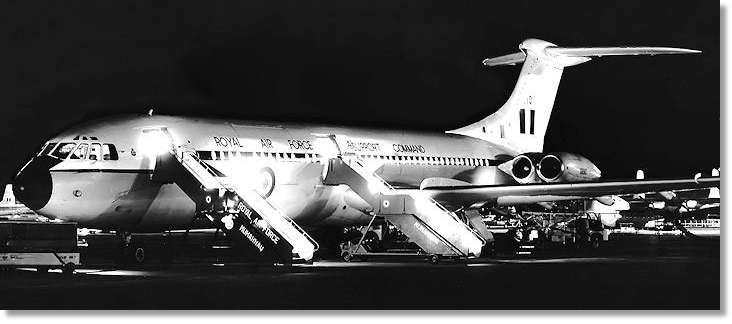

From: Dougie Russell, Carlisle, Cumbria
Subject: Memories of the Queen of the Skies
Hi Tony,
I had many memories of the “Queen of the Skies” over the 24 years I served, of which 12 were at Brize Norton and the VC-10 in multi-role. I think I loaded all of them in every role over the years.
Most memorable was a trip to Las Vegas for Exercise Red Flag in the 1990’s. We went via Canada on the way out and the Azores on the way back “towing" the Tonkas (Tornados) and having to be refuelled in mid air by a 101 Sqn VC-10 was certainly an experience never to be forgotten.
Regards
Dougie
Subject: Memories of the Queen of the Skies
Hi Tony,
I had many memories of the “Queen of the Skies” over the 24 years I served, of which 12 were at Brize Norton and the VC-10 in multi-role. I think I loaded all of them in every role over the years.
Most memorable was a trip to Las Vegas for Exercise Red Flag in the 1990’s. We went via Canada on the way out and the Azores on the way back “towing" the Tonkas (Tornados) and having to be refuelled in mid air by a 101 Sqn VC-10 was certainly an experience never to be forgotten.
Regards
Dougie

From: Robert Taylor, Doncaster, South Yorks
Subject: Memories of the Queen of the Skies
Hi Tony,
It was 1976 and just three months until my demob at Brize. It was the second night shift of two, very early hours of the morning, VC-10 on chocks ready for departure to Hong Kong via Akrotiri, Gan and Changi.
My team and I arrived back at the cargo hangar for a brew and we were told there is a very, very important person who must get on this flight for Akrotiri. I jumped into the Landrover and raced up to the pax terminal. There were no other aircraft on the pans except for ours tucked away in corner. I might have reached a speed of 40 mph, well over the airfield speed limit. I grabbed his suitcase and him (I didn’t have a clue who he was). By this time other team members had positioned the steps at the front door of the aircraft. Our special passenger ran up the aircraft steps and I loaded his baggage in the front hold.
The steps were pulled back and I indicated to the captain that all was good. The aircraft left five minutes late. I got a "well done" from the DAMO and everybody was happy. All was well, until...
My next day shift I was called into the DAMO's office. Apparently an engineering squadron leader saw me speeding across the pans to the pax terminal and then to the aircraft and wanted me charged. The DAMO stood up for me and explained the reasons but to no avail; he still wanted me charged!
To cut the story short, after going in front of both DAMO and SAMO (who thanked me for my quick response in not delaying the flight) they couldn’t dish out any punishment as the charge had to be read in front of the station commander. I was fined £25.00 which was a lot of money to me back then. It ruined my clean record on discharge but the group captain thanked me in private!
The twist is to this day I do not know who paid my fine.
Rob Taylor
p.s. I loved working the Queen in both the full pax and freighter roles.
Subject: Memories of the Queen of the Skies
Hi Tony,
It was 1976 and just three months until my demob at Brize. It was the second night shift of two, very early hours of the morning, VC-10 on chocks ready for departure to Hong Kong via Akrotiri, Gan and Changi.
My team and I arrived back at the cargo hangar for a brew and we were told there is a very, very important person who must get on this flight for Akrotiri. I jumped into the Landrover and raced up to the pax terminal. There were no other aircraft on the pans except for ours tucked away in corner. I might have reached a speed of 40 mph, well over the airfield speed limit. I grabbed his suitcase and him (I didn’t have a clue who he was). By this time other team members had positioned the steps at the front door of the aircraft. Our special passenger ran up the aircraft steps and I loaded his baggage in the front hold.
The steps were pulled back and I indicated to the captain that all was good. The aircraft left five minutes late. I got a "well done" from the DAMO and everybody was happy. All was well, until...
My next day shift I was called into the DAMO's office. Apparently an engineering squadron leader saw me speeding across the pans to the pax terminal and then to the aircraft and wanted me charged. The DAMO stood up for me and explained the reasons but to no avail; he still wanted me charged!
To cut the story short, after going in front of both DAMO and SAMO (who thanked me for my quick response in not delaying the flight) they couldn’t dish out any punishment as the charge had to be read in front of the station commander. I was fined £25.00 which was a lot of money to me back then. It ruined my clean record on discharge but the group captain thanked me in private!
The twist is to this day I do not know who paid my fine.
Rob Taylor
p.s. I loved working the Queen in both the full pax and freighter roles.

From: Phil Smith, Exmouth, Devon
Subject: My very last VC-10 flight
After sitting in the back of various RAF transport aircraft for 1,700 hours and no real incidents of interest, my last VC-10 flight on 8 Dec 1988 was memorable for all the wrong reasons.
We arrived at RAF Leuchars from Gardermoen. Just before taxying out to head to Brize Norton the captain called for the steps to be replaced and he inspected the main undercarriage area of the aircraft. He kicked the tyres a few times and got back on. We took off and headed south.
Halfway into the flight there was a very loud bang followed by a vibration that was clearly felt throughout the aircraft flooring <Oops!>.
When approaching Brize Norton the ALM had a quiet word with me, telling me there was a possibility we would be involved in an emergency landing <Gulp!>. She instructed me to stand behind her if she had to deploy the emergency slide and fend-off any other passenger who thought it a good idea to get off the aircraft before the slide was deployed <OMG!>.
The other passengers were all Royal Marines returning from winter exercises in Norway. Not much of a contest, 40 trained killers against 1 RAF bloke.
Landed at a very frightening angle of Yaw (i.e.sideways) and finally came to a stop with many fire trucks in attendance. I do remember seeing a Fireman quickly inspect the main undercarriage area and shout "EVACUATE!". This seemed like a very good idea at the time and so we did. Off down the slide we all went. There was foam everywhere.
I found out afterwards that one on the main wheel tyres in the undercarriage bay had exploded and blown off the door. This in turn severed fuel lines to the engines at the rear of the aircraft.
I never did ask how many fully functioning engines we landed with; I really didn`t want to know.
I often wondered where the undercarriage door ended up. It could still be in someone's back garden in Smethwick after 30 years. You would have thought they might just have noticed.
Phil
Subject: My very last VC-10 flight
After sitting in the back of various RAF transport aircraft for 1,700 hours and no real incidents of interest, my last VC-10 flight on 8 Dec 1988 was memorable for all the wrong reasons.
We arrived at RAF Leuchars from Gardermoen. Just before taxying out to head to Brize Norton the captain called for the steps to be replaced and he inspected the main undercarriage area of the aircraft. He kicked the tyres a few times and got back on. We took off and headed south.
Halfway into the flight there was a very loud bang followed by a vibration that was clearly felt throughout the aircraft flooring <Oops!>.
When approaching Brize Norton the ALM had a quiet word with me, telling me there was a possibility we would be involved in an emergency landing <Gulp!>. She instructed me to stand behind her if she had to deploy the emergency slide and fend-off any other passenger who thought it a good idea to get off the aircraft before the slide was deployed <OMG!>.
The other passengers were all Royal Marines returning from winter exercises in Norway. Not much of a contest, 40 trained killers against 1 RAF bloke.
Landed at a very frightening angle of Yaw (i.e.sideways) and finally came to a stop with many fire trucks in attendance. I do remember seeing a Fireman quickly inspect the main undercarriage area and shout "EVACUATE!". This seemed like a very good idea at the time and so we did. Off down the slide we all went. There was foam everywhere.
I found out afterwards that one on the main wheel tyres in the undercarriage bay had exploded and blown off the door. This in turn severed fuel lines to the engines at the rear of the aircraft.
I never did ask how many fully functioning engines we landed with; I really didn`t want to know.
I often wondered where the undercarriage door ended up. It could still be in someone's back garden in Smethwick after 30 years. You would have thought they might just have noticed.
Phil

From: Brian Hunt, Brighton, East Sussex
Subject: Memories of the Queen of the Skies
Dear Tony,
I don’t recall having any adventures on VC10s but attach a couple of snaps of VC10s in Kai Tak that you may find useful. The pictures were taken in 1975, so things have changed a bit since then!
Kind regards
Brian
Subject: Memories of the Queen of the Skies
Dear Tony,
I don’t recall having any adventures on VC10s but attach a couple of snaps of VC10s in Kai Tak that you may find useful. The pictures were taken in 1975, so things have changed a bit since then!
Kind regards
Brian
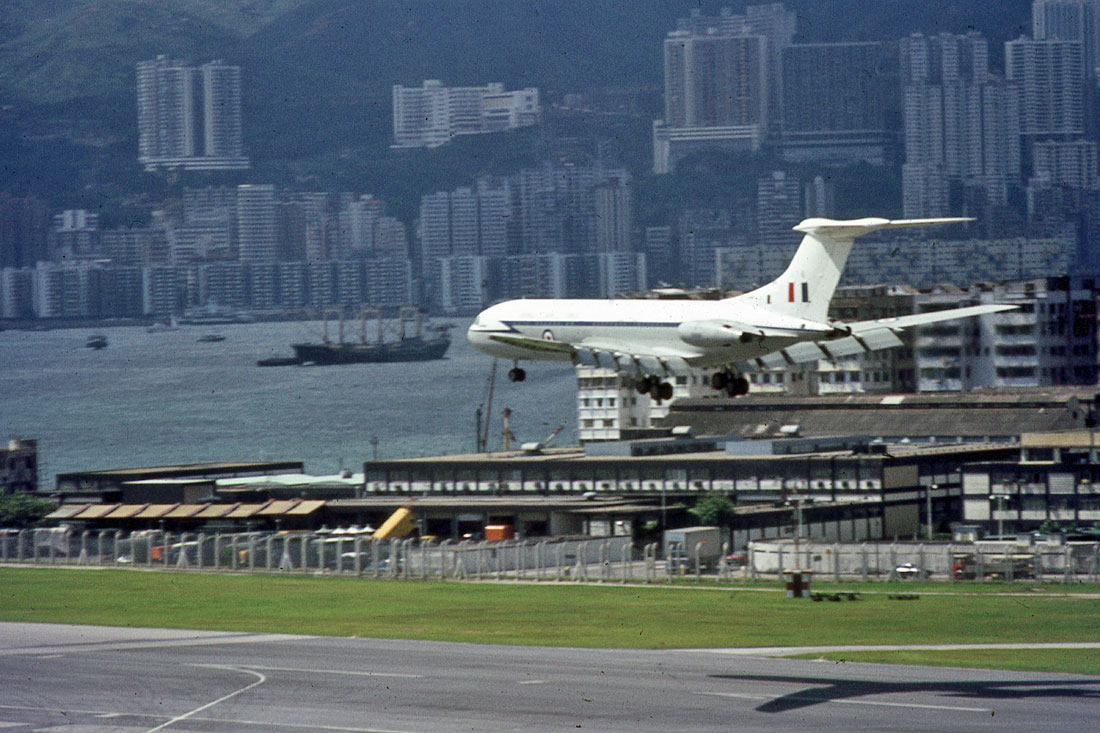
From: Mike Stepney, Stewarton, East Ayrshire
Subject: Memories of the Queen of the Skies
The Vickers VC10 (the Funbus), The Queen of the Sky, envied and copied (unsuccessfully) by others. The fastest ‘mean cruising speed’ of any passenger airliner and it still, I believe, holds the record of the fastest crossing of the Atlantic by a sub-sonic jet airliner, in a time of 5 hours and 1 minute; with 47 years-service with the RAF on passenger, freighter and tanker duties, what more can you say really; we certainly got our money’s worth out of those 14 airframes.
Although I had little or no association in my early career with RAF VC10’s, my initial introduction to the aircraft was early one morning at Gatwick in late November 1965. Having spent the first six months of my career on initial and then trade training, after a spot of embarkation leave, I found myself late at night on 28thNov 1965 at Euston Station, being shepherded by a pongo ‘mover’ (and I use that term very loosely), onto a bus, and after much confusion and additional collections of various bods from other main-line London rail stations, we headed for Gatwick. This was to be my first unit supply posting since completing training! It turned out that this was also my first flight (since joining the RAF). The VC10 was operated by BUA, a charter, moving troops to/from Khormaksar - Aden. Luck would have it that my end of tour flight back to UK was also by VC10 on 26th/27th Nov 1967. This time it was a BOAC aircraft and our journey was interrupted by a refuelling stop at Nairobi, as the normal route north was still being disrupted by the fall-out from the six day Arab/Israeli war of June 67. After that flight, apart from the odd sighting at air shows, I had very little involvement with VC10’s, that is, until I entered the ‘Movements’ world.
Not long after being posted to UKMAMS I quickly became used to handling VC10s. For some reason there appeared to be a bit of sloping shoulders when it came to finding someone on the team to complete the VC10 trim – everyone appeared to have more important duties to attend to, leaving yours truly attempting to trim the beast.
Subject: Memories of the Queen of the Skies
The Vickers VC10 (the Funbus), The Queen of the Sky, envied and copied (unsuccessfully) by others. The fastest ‘mean cruising speed’ of any passenger airliner and it still, I believe, holds the record of the fastest crossing of the Atlantic by a sub-sonic jet airliner, in a time of 5 hours and 1 minute; with 47 years-service with the RAF on passenger, freighter and tanker duties, what more can you say really; we certainly got our money’s worth out of those 14 airframes.
Although I had little or no association in my early career with RAF VC10’s, my initial introduction to the aircraft was early one morning at Gatwick in late November 1965. Having spent the first six months of my career on initial and then trade training, after a spot of embarkation leave, I found myself late at night on 28thNov 1965 at Euston Station, being shepherded by a pongo ‘mover’ (and I use that term very loosely), onto a bus, and after much confusion and additional collections of various bods from other main-line London rail stations, we headed for Gatwick. This was to be my first unit supply posting since completing training! It turned out that this was also my first flight (since joining the RAF). The VC10 was operated by BUA, a charter, moving troops to/from Khormaksar - Aden. Luck would have it that my end of tour flight back to UK was also by VC10 on 26th/27th Nov 1967. This time it was a BOAC aircraft and our journey was interrupted by a refuelling stop at Nairobi, as the normal route north was still being disrupted by the fall-out from the six day Arab/Israeli war of June 67. After that flight, apart from the odd sighting at air shows, I had very little involvement with VC10’s, that is, until I entered the ‘Movements’ world.
Not long after being posted to UKMAMS I quickly became used to handling VC10s. For some reason there appeared to be a bit of sloping shoulders when it came to finding someone on the team to complete the VC10 trim – everyone appeared to have more important duties to attend to, leaving yours truly attempting to trim the beast.
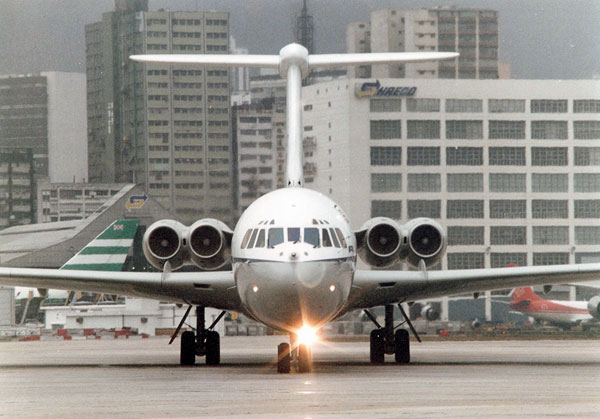
I did not find the trim sheets that onerous and quickly learned that the front and the ventral holds, held the key that could make or break the trim; simply amazing what we could get into that ventral hold! In my early days working with this aircraft, I quickly realised that VC10 Captains must have had a specific element of their training that demands they call for extra fuel fifteen minutes prior to chocks! I have lost count of the number of times I have been faced with a weight and balance change due to a very late requirement for additional fuel. Word would come down the line that Captain was going to top up the fuel reserve, Captains fuel! The initial outwardly calm appearance of the team leader would quickly deteriorate into a mad dash of activity to scribble down the new figures, find that aircraft was no longer in trim, try and work a quick plan of what to move from what hold to where, get the team moving the items, then complete the new trim and get sign-off, which was not that easy with ten minutes to chocks and facing a ‘Movements’ delay! After having this happen a couple of times, I quickly learned to include this type of late fuel uplift into my trim plans and had no great issues thereafter.
I undertook several VC10 tasks and had some interesting (interactions) with the crews. Unlike the more amiable C130 crews, I initially found the VC10 flight crews to be a little standoffish, and one or two could be a bit inflexible when dealing with Movements teams, but in general, over time, I had no major issues with them. Tasks included full freight config – hot loads from UK strike bases to Albuquerque and ammo outloads to RAF(G), pax/freight support of a number of UK and Germany Sqn Dets., Canadian tasks (Calgary) live firing exercises with the tank corps…, and even had a period as a Det Cdr for a number of different exercises including a large Maritime (Nimrod) exercise to San Juan Puerto Rico,with VC10s, C130’s and two Nimrods, where one of the two VC10’s happened to go u/s. This was a Conway issue, which necessitated an engine change, not the easiest thing to organise at a civilian airport in the Caribbean! VC10 engine problems appeared to follow me around during my time in Movements; as SAMO Kai Tak, we had a number of engine related issues with visiting VC10’s.
VC10 Captains, as part of the Captains certification, had to complete several approaches and landings at Kai Tak airport therefore, we had regular visits from VC10s, and group would assign them tasks when in theatre. During one of these tasks (UN Honour Guard rotation at Panmunjom in Korea), we experienced first-hand a VC10 engine failure in flight. We were returning to Hong Kong and had been airborne for about an hour when over the South China Sea there was a sudden large thump (the whole aircraft shook); this was followed by alarm bells sounding from the cockpit and a sudden influx of dense smoke throughout the cabin, other than quickly getting into my seat and strapping-in, I can’t remember much of the next few minutes until the smoke eventually cleared, and the alarms gradually wound down. The Captain eventually advised that he had everything under control, and that we had lost an engine (inboard Starboard). We were NOT diverting to China, and would continue to Kai Tak! I remember one of the Gurkha’s asking “how will they find the engine in all that water”?! On arrival fire engines greeted us but were not required.
The Kai Tak engineers undertook an engine change the following day - a spare Conway was held at the Airport Unit Kai Tak, and the aircraft departed a couple of days or so behind schedule. Brize Norton sent one of their sooty Jengo’s out to have a look at the u/s engine, and he showed me the damage; two compressor blades had separated and lodged in the titanium shroud that surrounds the engine, and several other blades were damaged when they came into contact with the detached blades. Without the shroud, the blades would probably have cut through the engine casing and ruptured the fuel lines to the other engine and entered the pressurised cabin. It is interesting to note that the RR engineers of the day had limited test machinery with which to test engines prior to completion.
VC10 Captains, as part of the Captains certification, had to complete several approaches and landings at Kai Tak airport therefore, we had regular visits from VC10s, and group would assign them tasks when in theatre. During one of these tasks (UN Honour Guard rotation at Panmunjom in Korea), we experienced first-hand a VC10 engine failure in flight. We were returning to Hong Kong and had been airborne for about an hour when over the South China Sea there was a sudden large thump (the whole aircraft shook); this was followed by alarm bells sounding from the cockpit and a sudden influx of dense smoke throughout the cabin, other than quickly getting into my seat and strapping-in, I can’t remember much of the next few minutes until the smoke eventually cleared, and the alarms gradually wound down. The Captain eventually advised that he had everything under control, and that we had lost an engine (inboard Starboard). We were NOT diverting to China, and would continue to Kai Tak! I remember one of the Gurkha’s asking “how will they find the engine in all that water”?! On arrival fire engines greeted us but were not required.
The Kai Tak engineers undertook an engine change the following day - a spare Conway was held at the Airport Unit Kai Tak, and the aircraft departed a couple of days or so behind schedule. Brize Norton sent one of their sooty Jengo’s out to have a look at the u/s engine, and he showed me the damage; two compressor blades had separated and lodged in the titanium shroud that surrounds the engine, and several other blades were damaged when they came into contact with the detached blades. Without the shroud, the blades would probably have cut through the engine casing and ruptured the fuel lines to the other engine and entered the pressurised cabin. It is interesting to note that the RR engineers of the day had limited test machinery with which to test engines prior to completion.
The link here gives you an idea of how RR operated in those days and how they tested the completed compressor blade assembly:
https://www.britishpathe.com/video/conway-engine-production
Pay particular attention from frame 02:09 where the test of the compressor blade attachment appears to require the test engineer to hold a metal rule against the spinning blades, about as high tech as a railway worker undertaking a ‘wheel-tapper’ test of rail freight wagons! All I can say is having seen this I am surprised that the aircraft engines performed as well as they did, but I can see now why they included a titanium shroud!
Great aircraft, and like many that have departed the Service, sadly missed.
https://www.britishpathe.com/video/conway-engine-production
Pay particular attention from frame 02:09 where the test of the compressor blade attachment appears to require the test engineer to hold a metal rule against the spinning blades, about as high tech as a railway worker undertaking a ‘wheel-tapper’ test of rail freight wagons! All I can say is having seen this I am surprised that the aircraft engines performed as well as they did, but I can see now why they included a titanium shroud!
Great aircraft, and like many that have departed the Service, sadly missed.
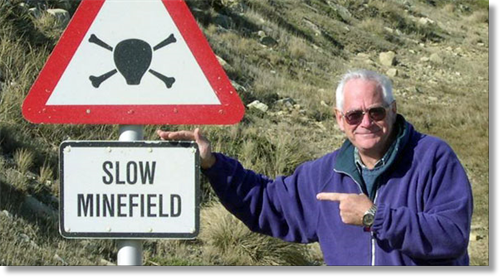

From: David Moss, Sorbie, Dumfries and Galloway
Subject: Queen of the Skies
My first contacts with the VC10 were in Aden 1966-67. Those movers who were out there then will remember just how much baggage we were having to get into those belly holds during the families repatriation phase of the withdrawal. It wasn't just how much there was, it was more a matter of what it consisted of; push chairs, prams, golf bags, fishing tackle and some really hefty suitcases. Thank goodness for that ventral hold access hatch under the tail, but I often wondered how those baggage restraints managed to hold the weight we put behind them, because these of course were the BUA aircraft that did the trooping flights then and some of the nets often looked a bit iffy.
There was a thank you party organised for us in Neddy's bar once all the families were gone which probably cleared a large part of the beer supplies from the main NAAFI warehouse, and certainly caused a few serious headaches next day.
One of the perks at Khormaksar was for the team that had loaded the Beverley that was taking the local Arab army rations to their upcountry bases. This was probably the worst load of any night shift that usually consisted of one of their Bedford four-tonners which almost always had something leaking from it which was usually very sticky, bags of flour, sugar and charcoal which managed to get into some very uncomfortable parts of our anatomy.
The reward for this task was that the team got to deal with the BOAC VC-10 that used to come through and used the military pan rather that the civil airport as they were a bit wary about what might happen to it there. The good bit was that the "Mucky Mob" all used to stand below the ventral rear access door and as the dirtiest of us scrambled up the baggage conveyor and opened that hatch, we all got an ice cold shower as several gallons of condensation and sometimes some lumps of ice tumbled out all over us. It made the horrid job from earlier almost worthwhile.
There was one instance when this went a bit wrong though as one time when the hatch was opened almost no water came out, just a large chunk of ice which hit the lad that was up the conveyor with the result that he ended up with a few stitches and was declared unfit for his 24 hour guard duty that night due to having concussion (every cloud does after all have a silver lining, but it came at a price).
The RAF VC-10s that served of course were used for all sorts of tasks and were still in service when I left in 1977, but they certainly earned their eventual retirement.
Subject: Queen of the Skies
My first contacts with the VC10 were in Aden 1966-67. Those movers who were out there then will remember just how much baggage we were having to get into those belly holds during the families repatriation phase of the withdrawal. It wasn't just how much there was, it was more a matter of what it consisted of; push chairs, prams, golf bags, fishing tackle and some really hefty suitcases. Thank goodness for that ventral hold access hatch under the tail, but I often wondered how those baggage restraints managed to hold the weight we put behind them, because these of course were the BUA aircraft that did the trooping flights then and some of the nets often looked a bit iffy.
There was a thank you party organised for us in Neddy's bar once all the families were gone which probably cleared a large part of the beer supplies from the main NAAFI warehouse, and certainly caused a few serious headaches next day.
One of the perks at Khormaksar was for the team that had loaded the Beverley that was taking the local Arab army rations to their upcountry bases. This was probably the worst load of any night shift that usually consisted of one of their Bedford four-tonners which almost always had something leaking from it which was usually very sticky, bags of flour, sugar and charcoal which managed to get into some very uncomfortable parts of our anatomy.
The reward for this task was that the team got to deal with the BOAC VC-10 that used to come through and used the military pan rather that the civil airport as they were a bit wary about what might happen to it there. The good bit was that the "Mucky Mob" all used to stand below the ventral rear access door and as the dirtiest of us scrambled up the baggage conveyor and opened that hatch, we all got an ice cold shower as several gallons of condensation and sometimes some lumps of ice tumbled out all over us. It made the horrid job from earlier almost worthwhile.
There was one instance when this went a bit wrong though as one time when the hatch was opened almost no water came out, just a large chunk of ice which hit the lad that was up the conveyor with the result that he ended up with a few stitches and was declared unfit for his 24 hour guard duty that night due to having concussion (every cloud does after all have a silver lining, but it came at a price).
The RAF VC-10s that served of course were used for all sorts of tasks and were still in service when I left in 1977, but they certainly earned their eventual retirement.

From: Gordon Gray, Allestree, Derby
Subject: VC10 Queen of the Skies
Gosh, this one takes me back. Unless I'm mistaken, XR 808 was the first VC10 delivered to 10 Squadron at Fairford/Brize in '66. The OC to be one Wg. Cdr. Beavis, later ACM Sir Michael whom I last met in South Cyprus in July 2012 during the Red Arrows summer work up. I also remember when it was announced that all VC10 Captains were to be promoted to Sqn. Ldr. On one occasion the tall Wg. Cdr. Beavis came through the recently completed Passenger Terminal to Ops and my DAMO said 'watch out for this guy, he's going places' and of course he did indeed!
In '67 I had much involvement with the '10's' at a time when we operated a Passenger Terminal from the Old Safety Equipment building at Brize and passengers were bussed over to Fairford (during the Brize runway resurfacing) where VC10's were pre-positioned. That was just before my posting overseas back on Supply duties in Malta. Then on return to Brize in '72 onto Movements but this time in the new Air Terminal and trooping was in full swing.
But, getting to the point of my memories, on a 2nd spell of UKMAMS training in '81 (the first in '77) at Lyneham, one of the modules included marshalling aircraft wherever, in theatre. I distinctly remembered dear old "Uncle Reg" (Carey) emphasising the growing swept wing effect of the VC10. Of course we had no opportunity at simulation in a classroom. However, on MAMS Task 115/82, 1 - 7 Mar '82, Ex. Alloy Express and Hardfall Recovery at Flesland (Bergen) our flow pattern was very extensive and erratic. During a busy handling of C130's and coupled with a VC10, a detached Ground Engineer fellow (of VASF/TASF) threw his bats at me half way through the VC10 coming on it's parking station and about to turn, telling me he's got see to another C130 waiting to come on the pan. With a wire fence on my right side and the port wingtip barely visible past the VC10 nose, I was frantically waving my right hand bat to swing the aircraft into line but realising there was no way without catching the fence, so, bats in the air, hands crossed and he virtually stopped dead.
I did learn from that, but oddly enough there were no known repercussions and I never did marshall again. But the nicely parked C130's were conspicuously let down by the disgusting position I'd left the VC10 in.
Happy days!
Gordon
Subject: VC10 Queen of the Skies
Gosh, this one takes me back. Unless I'm mistaken, XR 808 was the first VC10 delivered to 10 Squadron at Fairford/Brize in '66. The OC to be one Wg. Cdr. Beavis, later ACM Sir Michael whom I last met in South Cyprus in July 2012 during the Red Arrows summer work up. I also remember when it was announced that all VC10 Captains were to be promoted to Sqn. Ldr. On one occasion the tall Wg. Cdr. Beavis came through the recently completed Passenger Terminal to Ops and my DAMO said 'watch out for this guy, he's going places' and of course he did indeed!
In '67 I had much involvement with the '10's' at a time when we operated a Passenger Terminal from the Old Safety Equipment building at Brize and passengers were bussed over to Fairford (during the Brize runway resurfacing) where VC10's were pre-positioned. That was just before my posting overseas back on Supply duties in Malta. Then on return to Brize in '72 onto Movements but this time in the new Air Terminal and trooping was in full swing.
But, getting to the point of my memories, on a 2nd spell of UKMAMS training in '81 (the first in '77) at Lyneham, one of the modules included marshalling aircraft wherever, in theatre. I distinctly remembered dear old "Uncle Reg" (Carey) emphasising the growing swept wing effect of the VC10. Of course we had no opportunity at simulation in a classroom. However, on MAMS Task 115/82, 1 - 7 Mar '82, Ex. Alloy Express and Hardfall Recovery at Flesland (Bergen) our flow pattern was very extensive and erratic. During a busy handling of C130's and coupled with a VC10, a detached Ground Engineer fellow (of VASF/TASF) threw his bats at me half way through the VC10 coming on it's parking station and about to turn, telling me he's got see to another C130 waiting to come on the pan. With a wire fence on my right side and the port wingtip barely visible past the VC10 nose, I was frantically waving my right hand bat to swing the aircraft into line but realising there was no way without catching the fence, so, bats in the air, hands crossed and he virtually stopped dead.
I did learn from that, but oddly enough there were no known repercussions and I never did marshall again. But the nicely parked C130's were conspicuously let down by the disgusting position I'd left the VC10 in.
Happy days!
Gordon

From: Gerry Davis, Bedminster
Subject: RAF VC-10's
Yep, I worked on a few of these in my time. Living in Bristol, I used to pass by the Filton airfield quite often. Some years ago, in the late 70's, for a couple of years, there were 9 VC -10's cocooned in silver "Driclad" bags scattered about the airfield.
I was quite surprised when it was announced in the media that they were to be converted for use by the RAF as airbourne refueler tankers. The report gave the impression that these were new aircraft for the RAF; they were ex-British Airways, Gulf Airways and East African Airways Super VC-10's.
Gerry
Subject: RAF VC-10's
Yep, I worked on a few of these in my time. Living in Bristol, I used to pass by the Filton airfield quite often. Some years ago, in the late 70's, for a couple of years, there were 9 VC -10's cocooned in silver "Driclad" bags scattered about the airfield.
I was quite surprised when it was announced in the media that they were to be converted for use by the RAF as airbourne refueler tankers. The report gave the impression that these were new aircraft for the RAF; they were ex-British Airways, Gulf Airways and East African Airways Super VC-10's.
Gerry
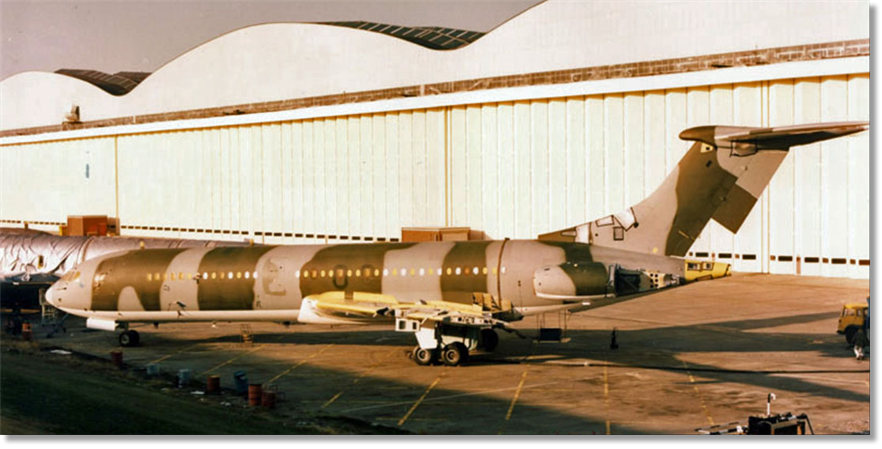
Outside the Brabazon hangar at Bristol Filton airfield, ZA141 slowly turning into a VC10 K2 tanker, with another airframe covered in a Driclad bag behind it

From: Paul English, Swindon, Wilts
Subject: Memories of the Queen of the Skies
First trip I had on a VC-10 was at end of my Movements Operator's course en route to Akrotiri and I was very surprised to see the rearwards facing seats. My worst experience on the10... being the slimmest on shift at Brize and shimmying under several rows of triples trying to lash down those that were overstowed ready to refit down route.
Vicky still has to be the best aircraft of all air transport.
Regards
Arfur
Subject: Memories of the Queen of the Skies
First trip I had on a VC-10 was at end of my Movements Operator's course en route to Akrotiri and I was very surprised to see the rearwards facing seats. My worst experience on the10... being the slimmest on shift at Brize and shimmying under several rows of triples trying to lash down those that were overstowed ready to refit down route.
Vicky still has to be the best aircraft of all air transport.
Regards
Arfur
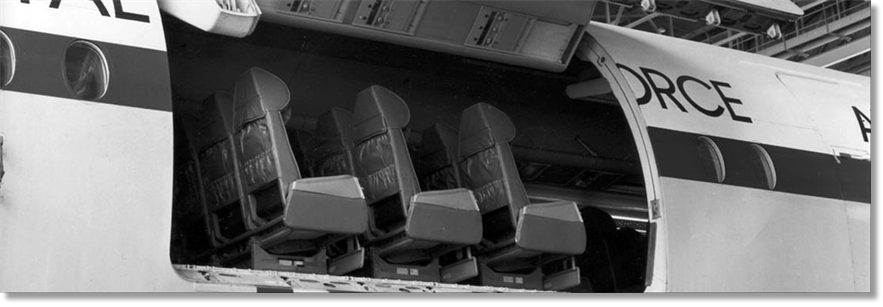

From: Len Bowen, Chisholm, ACT
Subject: Memories of the Queen of the Skies
Tony,
I'm disappointed in you. There was and ever will be only one 'Queen of the Skys' in the Air Movements world - until possibly the coming of the C17; the Blackburn Beverley.
However if you insist on stories about 'shiny fleet' minions, I'll see see what I can come up with.
Here is one for starters - and it will show how little we real TAC(MR) and TAC(SR) Movers cared for shiny birds. As you may know, when the VC10 entered RAF service it was decided that all VC10 captains should be Squadron Leaders, irrespective of previous seniority. This raised hackles in many places around the globe.
True story. Overheard one night in the Officers' Bar of the (in)famous Changi Creek Hotel just after the VC10s started the FEAF run: Charming and gorgeous WRAF officer being chatted up by a Sqn Ldr, who seemed quite happy about the way things were going... however .... She: "Before we go any further, are you a real Squadron Leader, or just a VC10 Captain?" End of a perfect evening down route - or should I say 'root'? Perhaps not that wouldn't be very PC these days, but the walls of the old Changi Creek Hotel could have told many tales before it was demolished.
Will try to come up with a couple of more printable of my encounters with the VC10. "Queen of the Skys" indeed. Bahhhh!
Rgds,
Len B
Subject: Memories of the Queen of the Skies
Tony,
I'm disappointed in you. There was and ever will be only one 'Queen of the Skys' in the Air Movements world - until possibly the coming of the C17; the Blackburn Beverley.
However if you insist on stories about 'shiny fleet' minions, I'll see see what I can come up with.
Here is one for starters - and it will show how little we real TAC(MR) and TAC(SR) Movers cared for shiny birds. As you may know, when the VC10 entered RAF service it was decided that all VC10 captains should be Squadron Leaders, irrespective of previous seniority. This raised hackles in many places around the globe.
True story. Overheard one night in the Officers' Bar of the (in)famous Changi Creek Hotel just after the VC10s started the FEAF run: Charming and gorgeous WRAF officer being chatted up by a Sqn Ldr, who seemed quite happy about the way things were going... however .... She: "Before we go any further, are you a real Squadron Leader, or just a VC10 Captain?" End of a perfect evening down route - or should I say 'root'? Perhaps not that wouldn't be very PC these days, but the walls of the old Changi Creek Hotel could have told many tales before it was demolished.
Will try to come up with a couple of more printable of my encounters with the VC10. "Queen of the Skys" indeed. Bahhhh!
Rgds,
Len B

From: Patrick Hirst, East Grinstead, West Sussex
Subject: Queen of the Skies
Dear Tony,
I have only twice flown on the VC10. The first time was on posting to Gulf MAMS, Muharraq, in 1971. About an hour before departure the aircraft was declared tech, so I had an overnight stay in the Gateway Hotel at Brize. The aircraft was declared serviceable the following day with a departure set for early evening. Due to the time difference, on arrival in Bahrain the bars on camp were closed so no customary drink was forthcoming. I was met by Cpl. Dave Reed who was instantly recognisable in his horn rimmed glasses (ex-39th Entry Admin App at Bircham Newton).
Very quiet aircraft inside the VC10, a pleasure to fly in, took some getting used to rear facing seats. When I was at RAF Fairford I was more used to flying in C130's in paratroopers seats, very uncomfortable; I clocked up many hours in them.
The second time in a VC10 was when our MAMF team was returning to Muharraq from doing a job to HKG (stayed there a week). Our aircraft was flying in front of a typhoon, very scary, took us as far as Gan where we picked up a Britannia coming out of Changi to get us to our home base.
Regards,
Paddy Hirst
Subject: Queen of the Skies
Dear Tony,
I have only twice flown on the VC10. The first time was on posting to Gulf MAMS, Muharraq, in 1971. About an hour before departure the aircraft was declared tech, so I had an overnight stay in the Gateway Hotel at Brize. The aircraft was declared serviceable the following day with a departure set for early evening. Due to the time difference, on arrival in Bahrain the bars on camp were closed so no customary drink was forthcoming. I was met by Cpl. Dave Reed who was instantly recognisable in his horn rimmed glasses (ex-39th Entry Admin App at Bircham Newton).
Very quiet aircraft inside the VC10, a pleasure to fly in, took some getting used to rear facing seats. When I was at RAF Fairford I was more used to flying in C130's in paratroopers seats, very uncomfortable; I clocked up many hours in them.
The second time in a VC10 was when our MAMF team was returning to Muharraq from doing a job to HKG (stayed there a week). Our aircraft was flying in front of a typhoon, very scary, took us as far as Gan where we picked up a Britannia coming out of Changi to get us to our home base.
Regards,
Paddy Hirst
Lorraine Hughes, Stourport on Severn, Worcs
From: Andrew Spinks, Aylsham, Norfolk
Subject: Memories of the Queen of the Skies
IMHO, the VC10 is indeed the ‘Queen of the Skies’, not least because it just looked right – “mighty fine” as our cousins across the water might say. I first flew on one in about 1971 and, after less-comfortable flights in AT aircraft such as Britannia, Argosy and Hercules, the VC10 was just such a leap forward in its comfort and noise level (well, quiet inside the cabin after the flaps came up, less peaceful for those on the ground of course). But, my happiest memory of the VC10 was in Kathmandu.
As F Troop team leader from 1975-1979, I had already flown hundreds of hours in the VC10 but was particularly fortunate to be selected for the Gurkha Trooping detachment in Kathmandu, which was a deployed team of just one officer and one SNCO. This 4-month detachment was certainly the highlight of my MAMS tour as I hope it was for my trusty team member Sergeant Mick Day.
Our Gurkha Trooping season was from September to December 1976, with 52 VC10 flights scheduled over a 3-month period. The same frame flew HKG-CCU-KTM on a Monday (night-stop), KTM-CCU-HKG on a Tuesday, back up to KTM for another night-stop on Wednesday, back to HKG Thursday, up to KTM for the last night-stop of the week on Friday, and back to HKG on Saturday. Two operating crews took turns to fly the schedules so we got to know them really well, not least because we all shared the same accommodation in ‘Britannia House’ on the outskirts of the city. We certainly all operated as a close team (operating crew and ground crew) and the results were impressive: 52 exactly on-time departures from KTM out of 52.
Gurkha Trooping ran in 2 seasons each year: the first started when the India/Nepal Monsoon finished (late September) and continued until Christmas. The next detachment started in January and ended before the Monsoon arrived in April. But it was never an easy start to the Autumn detachment, in spite of the pleasant positioning flights with Cathay Pacific and Royal Nepal Airlines through BKK, because our first task was to erect the infamous Britannia Freight Lift Platform (BFLP), which had been duly dismantled by the previous detachment and stored inside during the Monsoon. The rest of the RAF had long since progressed to the Condec 25K but one was never delivered to KTM as we were ‘lucky’ to have a BFLP and surely that was good enough for us? What a b*****d it was to put together although, to its credit, it worked quite well when up and running.
Subject: Memories of the Queen of the Skies
IMHO, the VC10 is indeed the ‘Queen of the Skies’, not least because it just looked right – “mighty fine” as our cousins across the water might say. I first flew on one in about 1971 and, after less-comfortable flights in AT aircraft such as Britannia, Argosy and Hercules, the VC10 was just such a leap forward in its comfort and noise level (well, quiet inside the cabin after the flaps came up, less peaceful for those on the ground of course). But, my happiest memory of the VC10 was in Kathmandu.
As F Troop team leader from 1975-1979, I had already flown hundreds of hours in the VC10 but was particularly fortunate to be selected for the Gurkha Trooping detachment in Kathmandu, which was a deployed team of just one officer and one SNCO. This 4-month detachment was certainly the highlight of my MAMS tour as I hope it was for my trusty team member Sergeant Mick Day.
Our Gurkha Trooping season was from September to December 1976, with 52 VC10 flights scheduled over a 3-month period. The same frame flew HKG-CCU-KTM on a Monday (night-stop), KTM-CCU-HKG on a Tuesday, back up to KTM for another night-stop on Wednesday, back to HKG Thursday, up to KTM for the last night-stop of the week on Friday, and back to HKG on Saturday. Two operating crews took turns to fly the schedules so we got to know them really well, not least because we all shared the same accommodation in ‘Britannia House’ on the outskirts of the city. We certainly all operated as a close team (operating crew and ground crew) and the results were impressive: 52 exactly on-time departures from KTM out of 52.
Gurkha Trooping ran in 2 seasons each year: the first started when the India/Nepal Monsoon finished (late September) and continued until Christmas. The next detachment started in January and ended before the Monsoon arrived in April. But it was never an easy start to the Autumn detachment, in spite of the pleasant positioning flights with Cathay Pacific and Royal Nepal Airlines through BKK, because our first task was to erect the infamous Britannia Freight Lift Platform (BFLP), which had been duly dismantled by the previous detachment and stored inside during the Monsoon. The rest of the RAF had long since progressed to the Condec 25K but one was never delivered to KTM as we were ‘lucky’ to have a BFLP and surely that was good enough for us? What a b*****d it was to put together although, to its credit, it worked quite well when up and running.
Anyway, back to the VC10’s noise. Weather in Kathmandu Valley in the Autumn was, in those days, highly predictable. Blue skies by day, pea-souper fog overnight. And even more predictable was the time the fog would clear: 0900-0930. So the VC10 was scheduled to depart at 1010 local time (0430 GMT, Nepal time being a brain-hurting 5 hrs 40 minutes ahead of GMT) and the departure inevitably drew a large crowd of local residents to watch and listen to the Queen of the Skies depart towards the Himalayas before turning south and on to Calcutta. In the still-cold temperature of just above zero, the 4 Conways were ear-shattering as it leapt into the blue sky and against the backdrop of the snow-covered Himalayas – it was a sight to behold (and one the crews usually made the most of!).
As a short postscript to my Kathmandu tale, I got a very surprising signal from Mike Perks in MAMS Ops while deployed on an 6-week detachment in Belize. He told me to get on the next flight home as I was returning to Kathmandu for a second 4-month stint. This was unprecedented so we had a short signal exchange about it being a wind-up before a less genial reply from Mike told me it was not a rubber dick and to get back asap.
MoD had decided to outsource Gurkha Trooping to Royal Nepal Airlines with a just-acquired and well-used 727 and they needed someone who had done it before to ensure the Royal Nepal operation ran as smoothly as when it was operated by the VC10 (and, to be fair, the Britannia before that). Eddie Gordon and I were duly despatched - another BLFP build, sigh - and, although the Royal Nepal operation was not without its issues including an emergency landing in KTM with the nose-wheel locked up, the second detachment as a whole was just as rewarding as the first.
As a short postscript to my Kathmandu tale, I got a very surprising signal from Mike Perks in MAMS Ops while deployed on an 6-week detachment in Belize. He told me to get on the next flight home as I was returning to Kathmandu for a second 4-month stint. This was unprecedented so we had a short signal exchange about it being a wind-up before a less genial reply from Mike told me it was not a rubber dick and to get back asap.
MoD had decided to outsource Gurkha Trooping to Royal Nepal Airlines with a just-acquired and well-used 727 and they needed someone who had done it before to ensure the Royal Nepal operation ran as smoothly as when it was operated by the VC10 (and, to be fair, the Britannia before that). Eddie Gordon and I were duly despatched - another BLFP build, sigh - and, although the Royal Nepal operation was not without its issues including an emergency landing in KTM with the nose-wheel locked up, the second detachment as a whole was just as rewarding as the first.
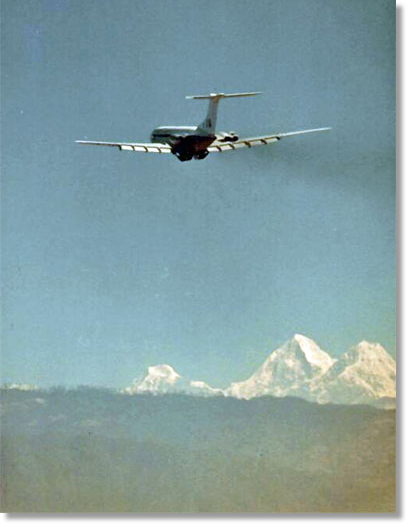
My work with the VC10 did not stop there though, as I was posted to Ottawa (where the Dulles Schedule used to stop twice a week – until the 1981 Defence Moratorium) and I was then re-posted to Calgary as the first permanent RAF Det Cdr for Medicine Man, which was also a predominantly VC10 task at the time. Thereafter, a short supply tour and an op tour in the Falklands before I was posted to Brize as SAMO in early 1983 for a healthy VC10 refresher.
So, all in all, the VC10 was a large part of my RAF life and I remember it with great affection. For me, it was truly the Queen of the Skies!
So, all in all, the VC10 was a large part of my RAF life and I remember it with great affection. For me, it was truly the Queen of the Skies!
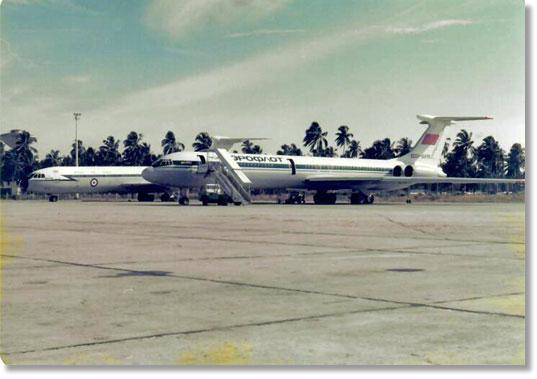
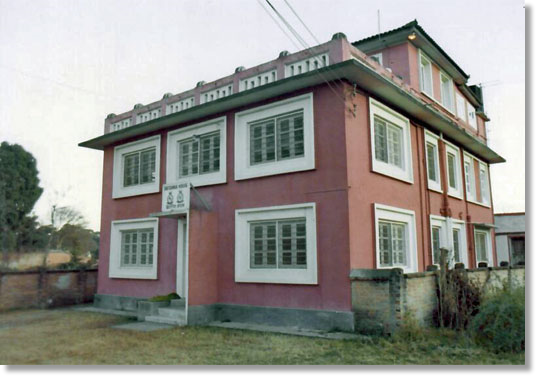
Britannia House in Kathmandu, where we lived and the VC10 crews stayed.
Colombo, Sri Lanka, showing the VC10 with its cloned twin from what was the USSR in those days.
From: Alan Potts, 11100 Narbonne
Subject: Queen of the Skies
My first encounter with the VC10 was whilst working in supply! As a corporal in the priority progression cell at HQTC in 1967, we were bombarded with calls from the Brize Norton priority cell chasing up outstanding diversion orders for parts that were allegedly grounding particular airframes. At one time Brize tried to put an a/c AOG for lack of the ‘toilet vacant/engaged ‘sign! Such was the prestige of the newly introduced aircraft that 10 Sqn wanted the aircraft to stay in a brand-new condition forever!
Two years later I was on shift at RAF Changi and we handled a daily scheduled VC10, in at 16.30 and out again at 19.30 local. Turning the aircraft round was never a problem and baggage loading and paperwork was completed in ample time.
Problems started when the passengers, who were processed and held at the Changi Creek Hotel, were boarded to coaches and driven to the aircraft steps. Often, many of those departing had been hosting ‘gozome’ parties in the Creek bar and arrived at the aircraft somewhat the worse for wear. Usually, the pax staff and the Loadie managed to get everyone seated but one Paxo was given a black eye one evening when trying to help an ‘attractive’ Loadie get a tipsy passenger to fasten his seat belt. Naturally the pax was offloaded and the Paxo had a lengthy report to write! Great days, great guys and gals and being part of the Changi movers brigade.
Subject: Queen of the Skies
My first encounter with the VC10 was whilst working in supply! As a corporal in the priority progression cell at HQTC in 1967, we were bombarded with calls from the Brize Norton priority cell chasing up outstanding diversion orders for parts that were allegedly grounding particular airframes. At one time Brize tried to put an a/c AOG for lack of the ‘toilet vacant/engaged ‘sign! Such was the prestige of the newly introduced aircraft that 10 Sqn wanted the aircraft to stay in a brand-new condition forever!
Two years later I was on shift at RAF Changi and we handled a daily scheduled VC10, in at 16.30 and out again at 19.30 local. Turning the aircraft round was never a problem and baggage loading and paperwork was completed in ample time.
Problems started when the passengers, who were processed and held at the Changi Creek Hotel, were boarded to coaches and driven to the aircraft steps. Often, many of those departing had been hosting ‘gozome’ parties in the Creek bar and arrived at the aircraft somewhat the worse for wear. Usually, the pax staff and the Loadie managed to get everyone seated but one Paxo was given a black eye one evening when trying to help an ‘attractive’ Loadie get a tipsy passenger to fasten his seat belt. Naturally the pax was offloaded and the Paxo had a lengthy report to write! Great days, great guys and gals and being part of the Changi movers brigade.
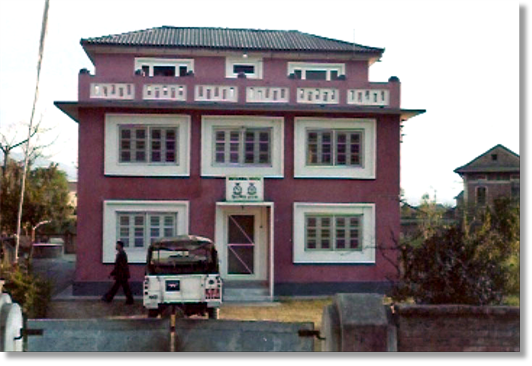
During my time on MAMS, our team, Romeo, had various tasks on the VC10 but my best experience with the ’Queen of the Skies’ was in Nepal. In late ’77, I went to Kathmandu with Fg Off Dick Leonard to handle the ‘Tendet’ Gurhka trooping flights from Hong Kong. We flew out courtesy of Fat Albert with plenty of supplies for our 4 months stay in Britannia House.
On arrival we were very busy as we had to check the Houchin over, make sure it would run as it was to be the source of ground power for the aircraft and the BFLP. That was once we got the BFLP erected, thankfully because of my tour on the movements school I had reasonable knowledge and also, we had a dry run through before we left UK.
Every couple of days the VC10 would arrive and night stop, departing next morning around 10:00 subject to the morning fog lifting. On arrival the first job was to marshall the aircraft to our particular pan away from the commercial traffic.
On arrival we were very busy as we had to check the Houchin over, make sure it would run as it was to be the source of ground power for the aircraft and the BFLP. That was once we got the BFLP erected, thankfully because of my tour on the movements school I had reasonable knowledge and also, we had a dry run through before we left UK.
Every couple of days the VC10 would arrive and night stop, departing next morning around 10:00 subject to the morning fog lifting. On arrival the first job was to marshall the aircraft to our particular pan away from the commercial traffic.
One of my most daunting experiences, standing in front of the massive aircraft and having to guide the pilot into what was a very small pan. The final turn was such that the starboard wing hung over a wall that was above the traffic on the road only some 20 feet below. I was certainly sweating when I finally crossed hands to halt the aircraft. However the fun did not stop there, most loads were pcf, with some full freight. Once the pax and crew were clear, the BFLP was run out and together with a team of local labourers we unchained and manhandled the heavy MFO boxes on to the BFLP and then into waiting trucks. Getting the local help to work at anything like an average pace was very difficult and the system was that, out of 8 chaps, at least one would be resting in the shade under the wing, and after 10 or 15 minutes the ‘restee’ would be changed. It also helped by dangling a carrot at the workers, after the first turn round the workers knew that they would be rewarded with western cigarettes once the offload was completed.
Often the hardest part was getting the Houchin started! Happy days great memories, and when not working we were able to explore the wonderful country.
My final encounter with the VC10 was as the Flt Lt ‘Gofer’ (SAMO Northolt) at Heathrow whenever government ministers or members of the Royal family were travelling on our wonderful aircraft.
Often the hardest part was getting the Houchin started! Happy days great memories, and when not working we were able to explore the wonderful country.
My final encounter with the VC10 was as the Flt Lt ‘Gofer’ (SAMO Northolt) at Heathrow whenever government ministers or members of the Royal family were travelling on our wonderful aircraft.
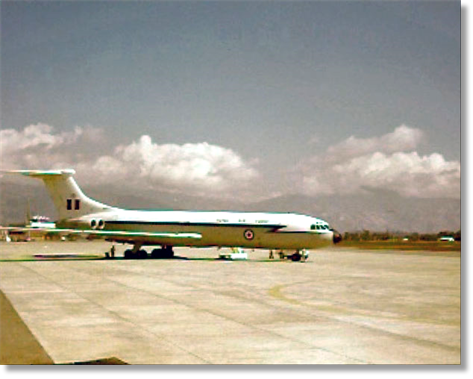
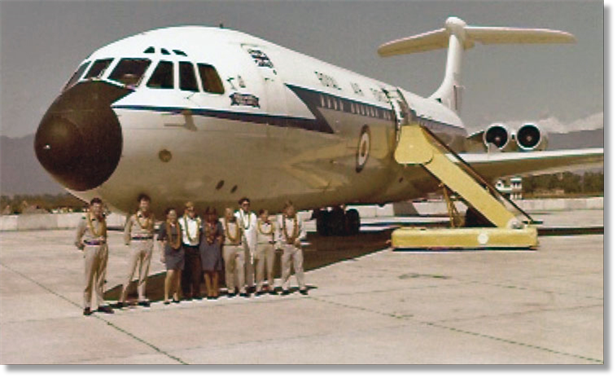

Britain's secret Vietnam war missions
Britain provided covert assistance to western forces in the Vietnam War by flying secret missions over Laos, the daughter of a former Royal Air Force navigator has claimed.
Flight Lieutenant Donald Roberts, who was based in Asia with the RAF at the time, confided in his family decades later that he had taken part in flying Handley Page Hastings transport aircraft over Laos in the second half of 1962.
The alleged secret flights were designed to help close off the Ho Chi Minh Trail, a key logistics route that was used to resupply the Viet Cong and North Vietnamese army fighting in the South. The RAF helped to transport New Zealand SAS personnel and other cargo to the remote and mountainous area, Roberts told his daughter, Priscilla Roberts, a professor at City University of Macau, years after the event.
She has detailed his narrative in a published paper for a Cold War history initiative convened by the Woodrow Wilson International Centre for Scholars, a think tank in Washington. Her father, who died in 2014, aged 84, was unable to provide proof of his claims, as he told his daughter that the airmen had been forbidden to record the flights in their logbooks.
He had, however, been permitted to record flights between his permanent base in Changi, Singapore, and Thailand. It was from Chiang Mai airfield in northern Thailand or Don Muang airport near Bangkok that the Laos missions were launched, he recalled. In one entry in his flying logbook he had written “Radio Compass Malfunction!” next to details of a flight from Singapore to Chiang Mai.
Flight Lieutenant Donald Roberts, who was based in Asia with the RAF at the time, confided in his family decades later that he had taken part in flying Handley Page Hastings transport aircraft over Laos in the second half of 1962.
The alleged secret flights were designed to help close off the Ho Chi Minh Trail, a key logistics route that was used to resupply the Viet Cong and North Vietnamese army fighting in the South. The RAF helped to transport New Zealand SAS personnel and other cargo to the remote and mountainous area, Roberts told his daughter, Priscilla Roberts, a professor at City University of Macau, years after the event.
She has detailed his narrative in a published paper for a Cold War history initiative convened by the Woodrow Wilson International Centre for Scholars, a think tank in Washington. Her father, who died in 2014, aged 84, was unable to provide proof of his claims, as he told his daughter that the airmen had been forbidden to record the flights in their logbooks.
He had, however, been permitted to record flights between his permanent base in Changi, Singapore, and Thailand. It was from Chiang Mai airfield in northern Thailand or Don Muang airport near Bangkok that the Laos missions were launched, he recalled. In one entry in his flying logbook he had written “Radio Compass Malfunction!” next to details of a flight from Singapore to Chiang Mai.

From: Roger Whittington, Prescot, Merseyside
Subject: RAF in Vietnam
Hi Tony,
I wonder if anyone remembers this, or indeed participated!
Cheers! Roger
Subject: RAF in Vietnam
Hi Tony,
I wonder if anyone remembers this, or indeed participated!
Cheers! Roger
Professor Roberts wrote, however: “My father confirmed to me that nothing of the sort had occurred. Given the particular sensitivity of this flight, with a British airplane ferrying NZSAS operatives on a mission into supposedly neutralised Laos, this entry may have been a precaution, just in case word of this flight did eventually leak out. In the interests of plausible deniability this would have allowed the British government to cite navigational difficulties as the reason for intruding into Laotian airspace.”
She added: “Tight security was evident in other aspects. My father recalled that as this group of men were waiting on the tarmac to board the aircraft he attempted to chat with the team members, introducing himself and asking who they were. Those who replied all laconically informed him that their name was ‘Smith’.”
Keeping the involvement over Laos secret would have been imperative to Britain as it had played a significant role in securing the neutral status of the nation in the war, having co-chaired a global conference to agree the terms. Britain, along with the US, Soviet Union, China and ten other nations, signed the deal in July 1962, pledging to respect the neutrality of Laos.
Roberts told his daughter that the first of six missions he flew over Laos took place just as the Geneva agreements were being signed. His explanation for Britain being drawn into Laos was that the RAF had the four-engine Handley Page Hastings aircraft, which were more reliable for flights over the mountainous terrain than America’s single and twin-engine aircraft.
London was also under immense political pressure from Washington to contribute in the war. Roberts said that at the end of 1962 he believed that the flights were taken over by Air America, the passenger and cargo airline secretly owned by the US government from 1950 to 1976.
Captain John Sullivan, 84, a friend of Roberts and a contemporary at RAF Changi in the 1960s, said that he had not been aware of the Laos flights but confirmed that secret missions had taken place. “It’s quite possible. We did occasionally do things like that, but I wasn’t involved [in these alleged flights],” he said.
A search of RAF records and declassified UK intelligence reports in the National Archives did not yield proof of the alleged missions but senior military figures believe that the claims are plausible. Air Chief Marshal Sir Michael Graydon, a former head of the RAF, said: “I cannot be sure that the flights described took place but the evidence is convincing; moreover, 48 Squadron was based at Changi up until 1967 and equipped at that time with the Hastings aircraft which, being four-engined, would have been better for operations in the rugged terrain of Laos than twin-engine aircraft.”
Professor Roberts, 63, said she hoped that her paper would encourage others with any knowledge of the missions to come forward.
The Times UK
She added: “Tight security was evident in other aspects. My father recalled that as this group of men were waiting on the tarmac to board the aircraft he attempted to chat with the team members, introducing himself and asking who they were. Those who replied all laconically informed him that their name was ‘Smith’.”
Keeping the involvement over Laos secret would have been imperative to Britain as it had played a significant role in securing the neutral status of the nation in the war, having co-chaired a global conference to agree the terms. Britain, along with the US, Soviet Union, China and ten other nations, signed the deal in July 1962, pledging to respect the neutrality of Laos.
Roberts told his daughter that the first of six missions he flew over Laos took place just as the Geneva agreements were being signed. His explanation for Britain being drawn into Laos was that the RAF had the four-engine Handley Page Hastings aircraft, which were more reliable for flights over the mountainous terrain than America’s single and twin-engine aircraft.
London was also under immense political pressure from Washington to contribute in the war. Roberts said that at the end of 1962 he believed that the flights were taken over by Air America, the passenger and cargo airline secretly owned by the US government from 1950 to 1976.
Captain John Sullivan, 84, a friend of Roberts and a contemporary at RAF Changi in the 1960s, said that he had not been aware of the Laos flights but confirmed that secret missions had taken place. “It’s quite possible. We did occasionally do things like that, but I wasn’t involved [in these alleged flights],” he said.
A search of RAF records and declassified UK intelligence reports in the National Archives did not yield proof of the alleged missions but senior military figures believe that the claims are plausible. Air Chief Marshal Sir Michael Graydon, a former head of the RAF, said: “I cannot be sure that the flights described took place but the evidence is convincing; moreover, 48 Squadron was based at Changi up until 1967 and equipped at that time with the Hastings aircraft which, being four-engined, would have been better for operations in the rugged terrain of Laos than twin-engine aircraft.”
Professor Roberts, 63, said she hoped that her paper would encourage others with any knowledge of the missions to come forward.
The Times UK

From: Roger Whittington, Prescot, Merseyside
Subject: John Haynes
Hi Tony,
I was reading the Times obituary of John Haynes, the writer of the automobile technical manuals, and it mentions that in the 1960s he was in charge of air movements in Aden. Is this true and can any OBA members remember him?
Regards, Roger
Subject: John Haynes
Hi Tony,
I was reading the Times obituary of John Haynes, the writer of the automobile technical manuals, and it mentions that in the 1960s he was in charge of air movements in Aden. Is this true and can any OBA members remember him?
Regards, Roger
From: Richard Lloyd, Dalgety Bay, Fife
Subject: Re: John Haynes
Hi Tony,
I know John was at Khormaksar well before me with a person called Dave Welch who became a great friend of mine (now lost touch). I don’t believe he was ever promoted beyond Flt Lt. I’m thinking who else might know - I’ll get back to you...
Best,
Richard
Subject: Re: John Haynes
Hi Tony,
I know John was at Khormaksar well before me with a person called Dave Welch who became a great friend of mine (now lost touch). I don’t believe he was ever promoted beyond Flt Lt. I’m thinking who else might know - I’ll get back to you...
Best,
Richard

From: Clive Price, Brecon
Subject: VC-10's - the shiny fleet!
Hello Tony,
Nice plane to fly in and big belly holds to work in. I flew in one to Canada, it had two crews which I thought was strange.
It kept flying after we refueled in Gander (big groans all around) and landed in Calgary; a total of fifteen hours flying. We offloaded and flew back home. No money spent or needed. Not the sort of trip we MAMS troopers liked.
Next was an exercise in southern Germany where the troops were flown in by VC-10's. We averaged ten minutes to unload the aircraft and turn them around. On the last one, as I closed the rear belly hold door, the aircraft captain noticed I had left a hand print on the door and ordered me to clean it off. No wonder they were known as the shiny fleet!
When they were empty they took off and climbed like a fighter plane, that alone was a sight to see and to hear those Conway engines!
Taff Price
Subject: VC-10's - the shiny fleet!
Hello Tony,
Nice plane to fly in and big belly holds to work in. I flew in one to Canada, it had two crews which I thought was strange.
It kept flying after we refueled in Gander (big groans all around) and landed in Calgary; a total of fifteen hours flying. We offloaded and flew back home. No money spent or needed. Not the sort of trip we MAMS troopers liked.
Next was an exercise in southern Germany where the troops were flown in by VC-10's. We averaged ten minutes to unload the aircraft and turn them around. On the last one, as I closed the rear belly hold door, the aircraft captain noticed I had left a hand print on the door and ordered me to clean it off. No wonder they were known as the shiny fleet!
When they were empty they took off and climbed like a fighter plane, that alone was a sight to see and to hear those Conway engines!
Taff Price
RAF VC10 Take-Off and Display - Biggin Hill, 2010

From: Phil Smith, Exmouth, Devon
Subject: Paddy`s Funeral - Tears and Laughter
Liz and her daughters would like to thank everyone who sent a message of condolence. It is greatly appreciated at this sad time.
Last week Gerry Muffett, my wife and I attended Paddy Gibson`s funeral in Lincoln. Gerry first met Paddy and Liz in 1964. Kathy and I met him in 1968 and kept in touch for over 50 years.
As funerals go, this one was 5-Star Deluxe. His coffin was RAF blue with the RAF flag and his SD Cap on top.
A lone piper in full uniform played Amazing Grace to lead the cortege for the final 50 meters or so. An ex-RAF British Legion Standard bearer lowered the Standard during the Last Post. A Royal Marine in full dress uniform sounded the Last Post. An SAC in his “ best blue “ attended. Many medals were to be seen.
The humorous tales were good.
When confronted by a "jumped up" RAF Corporal Police Dog Handler in 1968 and asked for his ID card, Paddy showed it to the dog.
The night he slept in a ditch because, under the influence and the Taxi Service telephone number had a lot of 9's in it, he kept getting the Emergency Services 999 number. He was asked on numerous occasions "What service do you require?" He replied, "A taxi service."
He told Liz when posted to Hong Kong that to combat the heat and dehydration he had to consume 8 pints of beer a day. It was a month or so later she finally realised he should be drinking 8 pints of water.
Subject: Paddy`s Funeral - Tears and Laughter
Liz and her daughters would like to thank everyone who sent a message of condolence. It is greatly appreciated at this sad time.
Last week Gerry Muffett, my wife and I attended Paddy Gibson`s funeral in Lincoln. Gerry first met Paddy and Liz in 1964. Kathy and I met him in 1968 and kept in touch for over 50 years.
As funerals go, this one was 5-Star Deluxe. His coffin was RAF blue with the RAF flag and his SD Cap on top.
A lone piper in full uniform played Amazing Grace to lead the cortege for the final 50 meters or so. An ex-RAF British Legion Standard bearer lowered the Standard during the Last Post. A Royal Marine in full dress uniform sounded the Last Post. An SAC in his “ best blue “ attended. Many medals were to be seen.
The humorous tales were good.
When confronted by a "jumped up" RAF Corporal Police Dog Handler in 1968 and asked for his ID card, Paddy showed it to the dog.
The night he slept in a ditch because, under the influence and the Taxi Service telephone number had a lot of 9's in it, he kept getting the Emergency Services 999 number. He was asked on numerous occasions "What service do you require?" He replied, "A taxi service."
He told Liz when posted to Hong Kong that to combat the heat and dehydration he had to consume 8 pints of beer a day. It was a month or so later she finally realised he should be drinking 8 pints of water.
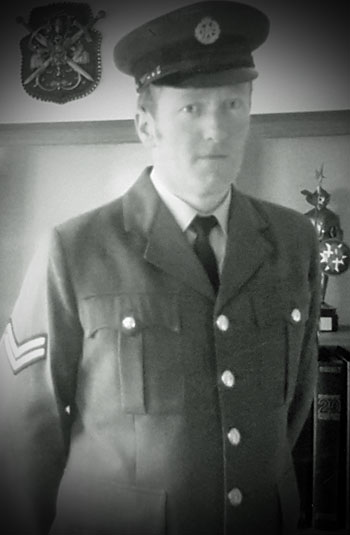
He challenged Big Brian Harper to an arm wrestling contest the night before he was promoted to the rank of Corporal and lost - badly! The station medical facility was visited the next day.
The last two years or so were very difficult for him. A triple heart bypass operation was required and leukemia had to be confronted.
The last time I saw Paddy was in Corralejo Fuerteventura in the Canaries, May 2017, on holiday.
Adios amigo.
The last two years or so were very difficult for him. A triple heart bypass operation was required and leukemia had to be confronted.
The last time I saw Paddy was in Corralejo Fuerteventura in the Canaries, May 2017, on holiday.
Adios amigo.
More Relevant Stuff
This Newsletter is Dedicated
To the Memories of:
John Haynes (RAF)
Cliff Mackey (RCAF)
Jack Madore (RCAF)
Suzy Viau-Walker (RCAF)
John "Paddy" Gibson (RAF)
To the Memories of:
John Haynes (RAF)
Cliff Mackey (RCAF)
Jack Madore (RCAF)
Suzy Viau-Walker (RCAF)
John "Paddy" Gibson (RAF)
If you wish to send a donation to the OBA
drop me an e-mail and I'll tell you how to do it.
Tony Gale
ukmamsoba@gmail.com
drop me an e-mail and I'll tell you how to do it.
Tony Gale
ukmamsoba@gmail.com












